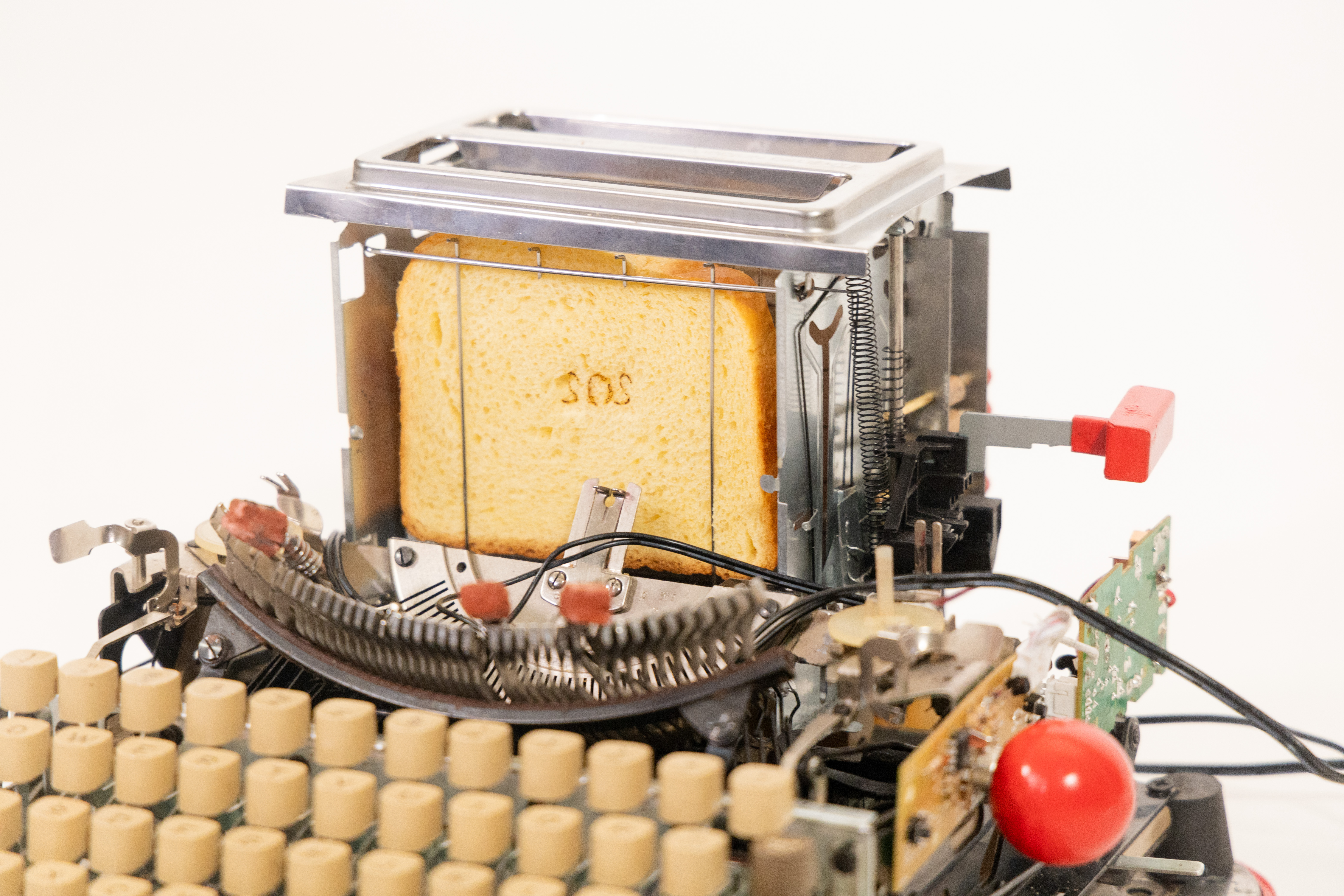
An Investigation of Humor in Design
We are too serious as a design and innovation industry. Humor is a tool we rarely take out of our toolboxes. We often claim that design can change the world, but design needs humor. This 15 week long investigation attempts to understand humor's role in design and creates futures where humor is embedded in our everyday objects and technologies. The machine, The Toaster-Typewriter is the first iteration of what technology with a sense of humor can look like.
Thesis Research for BFA Product Design
Completion: 15 May 2023
Duration: 15 weeks
Completion: 15 May 2023
Duration: 15 weeks

1. Inserting bread into The Toaster-Typewriter
Design is boring, where’s the humor?
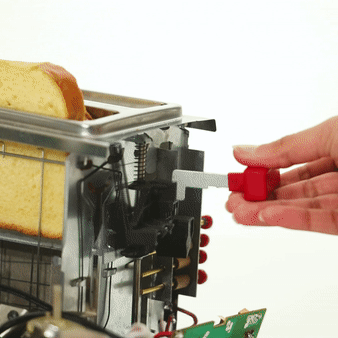
2. Adjusting height of bread to typeable level
Why do designers refrain from using humor?
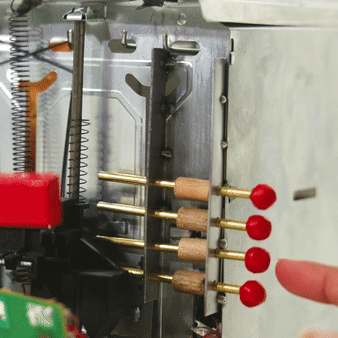
3. Locking the height with custom mechanism
What if comedians became designers?

4. Moving the bread with the help of castor wheels attached
Or designers became comedians?
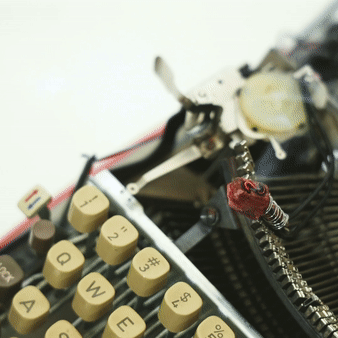
5. Pressing ‘S’ key to lift the letterhead towards the bread
What would objects of humor look like?

6. Burning the letter onto the bread, spelling out ‘SOS’
What even is humor?
A 15-Week Long Research Project
Humor is one of the least researched human emotions. A 15-week long expedition was conducted to fulfill that gap. Four routes of research emerged: ethnographic research, experimental research, somatic research and research through making. People, objects, body, process.

Manifesto
These 10 Commandments of Humor in Design form a new manifesto for good design. They are the real product of the research. The insights gathered from each of the multi-disciplinary sources were carefully laid out together to draw similarities. In one of the interviews, what a musician said about the sound of laughter was connected to the point made about rhythm of performance in the improv class to form a collective commandment. The ten commandments provide a new curriculum for design, and for thought.
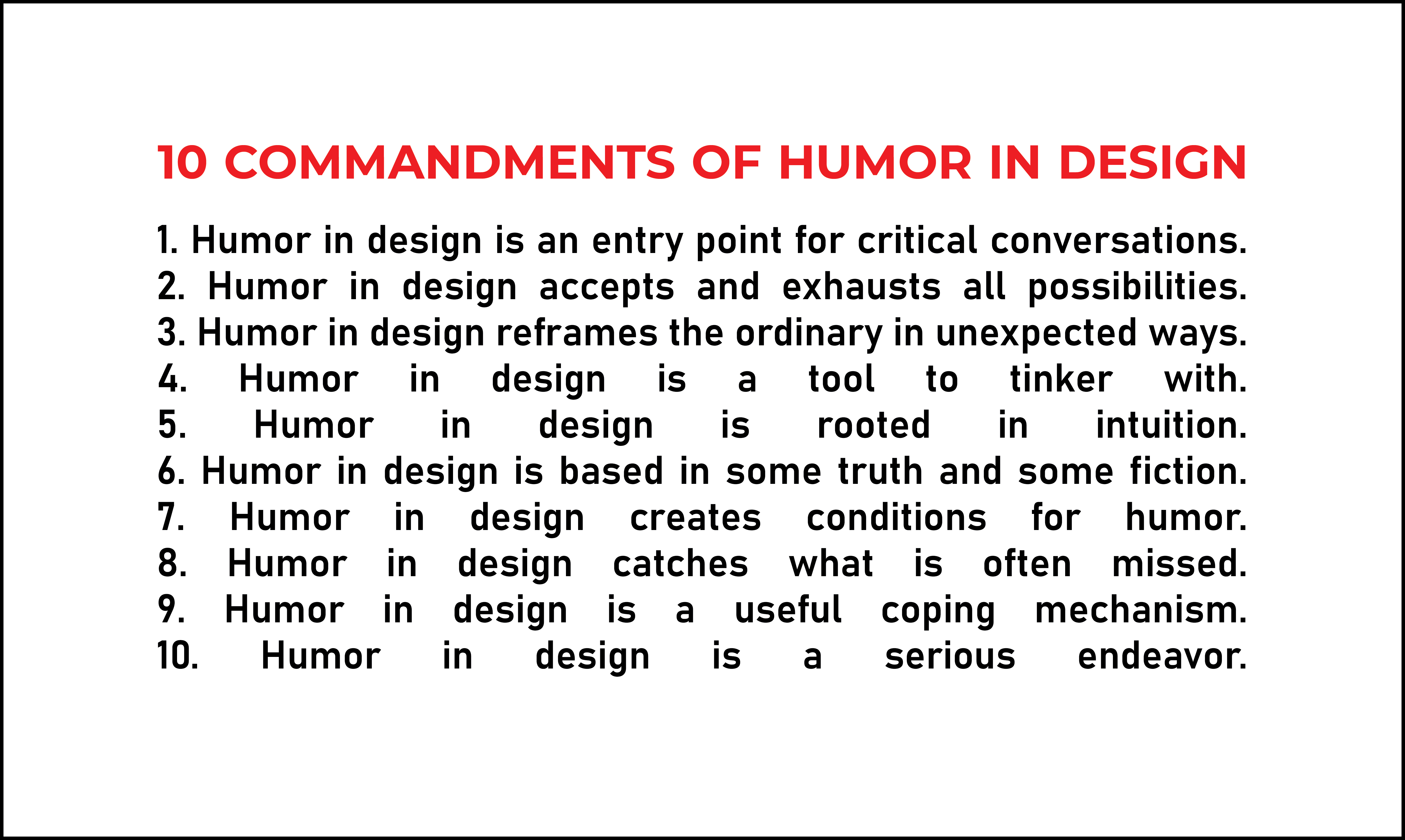
A. ETHNOGRAPHIC RESEARCH
Funny People Are Important
Real change is happening in the world through the strategic use of humor. Politicians have been using humor in speeches to sway audiences passively. Greta Thunberg uses humor to insult the same lying politicians. Educators use memes in their presentations to prevent disinterest. Musicians perform stand-up bits between songs. Funny people understand the serious impact of humor.
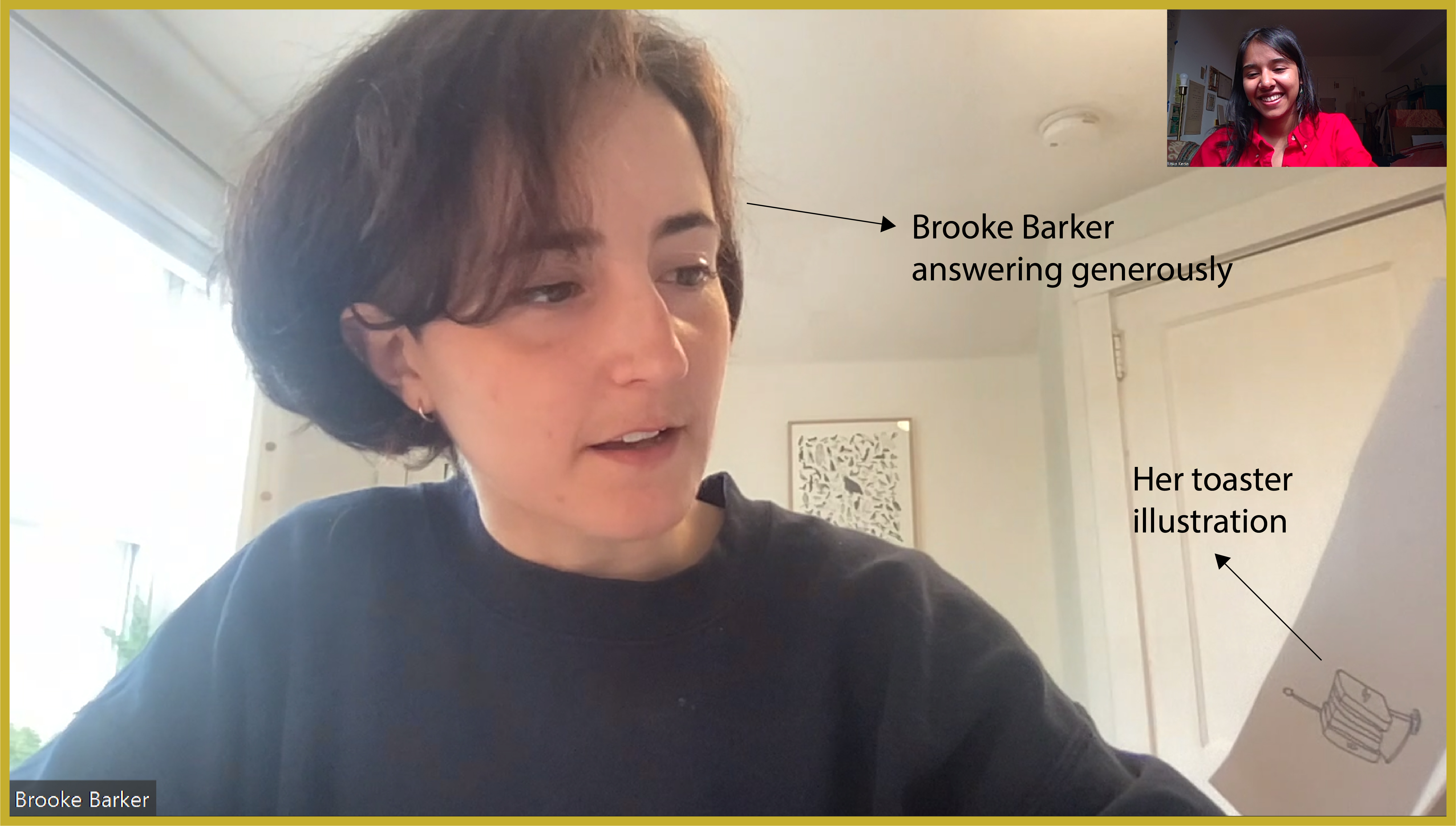
Humor Experts
11 individuals from diverse fields and backgrounds such as design, psychology, music, performance, acting, comic books, and storytelling, were interviewed to understand the varied functions of humor in each discipline, and how they have been successfully manipulating it.
- Anthony Dunne: Designer, Educator
-
Dr. Pani Farvid: Social Psychologist, Researcher, Educator
-
Tanya Kalmanovitch: Climate-Activist, Ethnomusicologist, Educator
-
Allan Wexler: Architect, Designer, Educator
- Peter Sim: Designer, Educator, CNC Technician
-
Brooke Barker: Illustrator, Writer
-
Nikki Bregman: Designer
-
John Murphy: Comedy Actor, Director, Writer, Educator
-
Matthew Leabo: Designer, Educator
-
Shubham Jumde: Designer
- Shubh Nanda: Comedian, Screenwriter
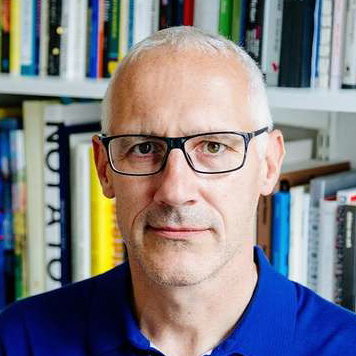


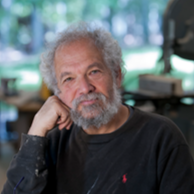




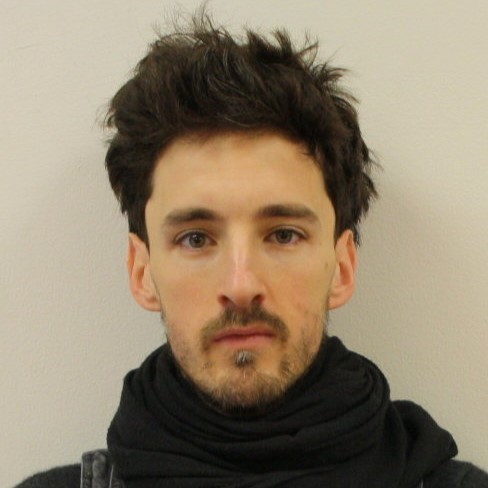
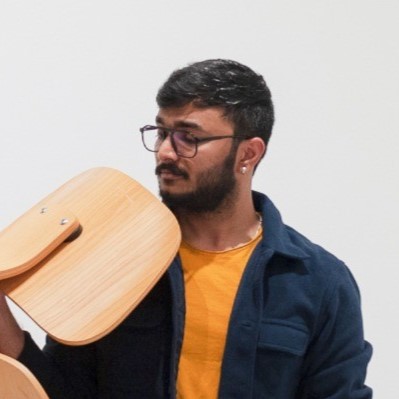

Interview Questions & Responses
The interviews were conducted over the span of 2 months, each interview was between 20-90 minutes long. Interviewees were asked common questions like: In what ways do you actively seek humor in your practice, or What is one joke that made you laugh recently? They were also asked questions specific to their fields like: Is humor an automatic environmental good, or What are the relationships between humor and absurdity?

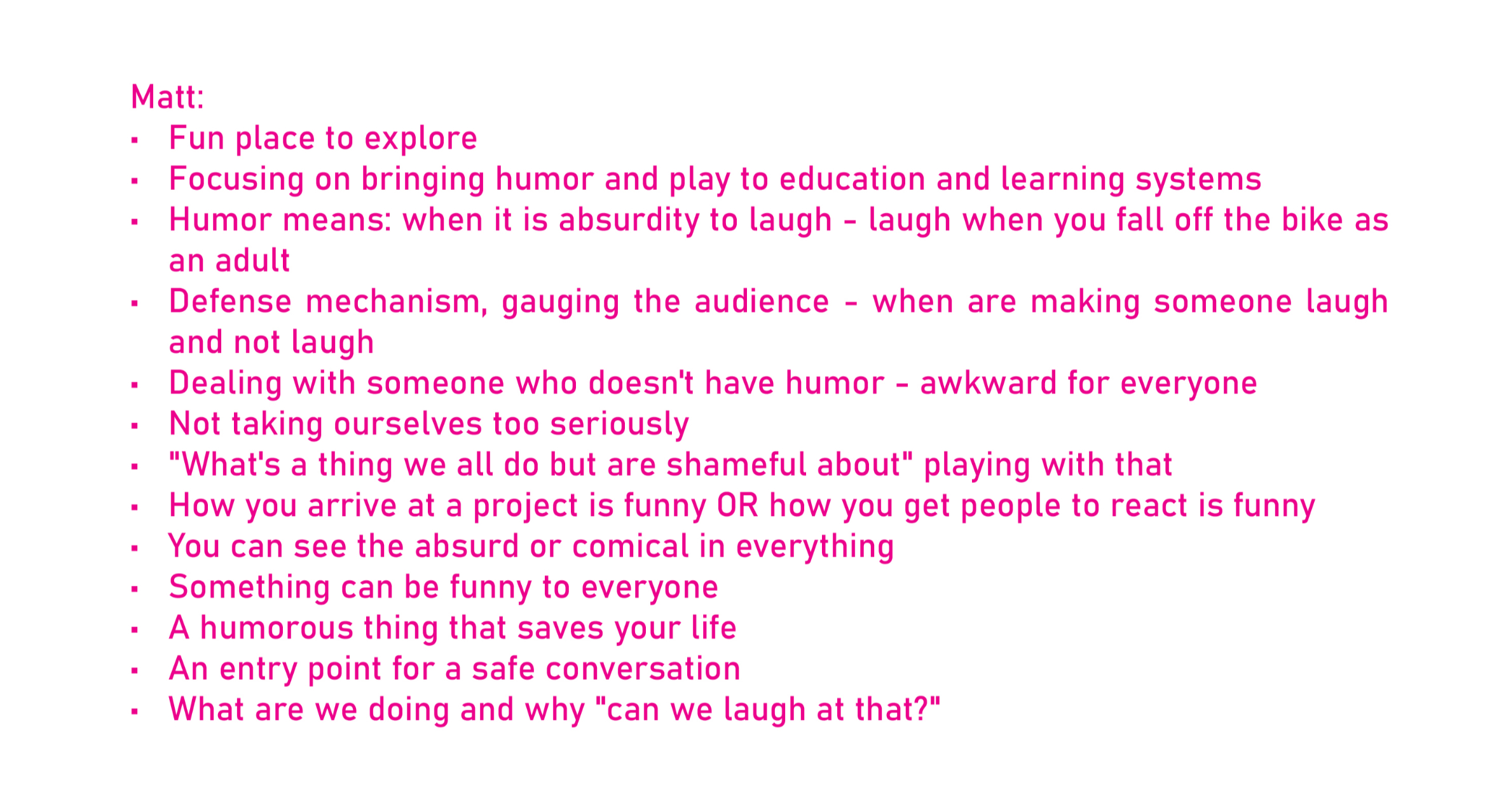

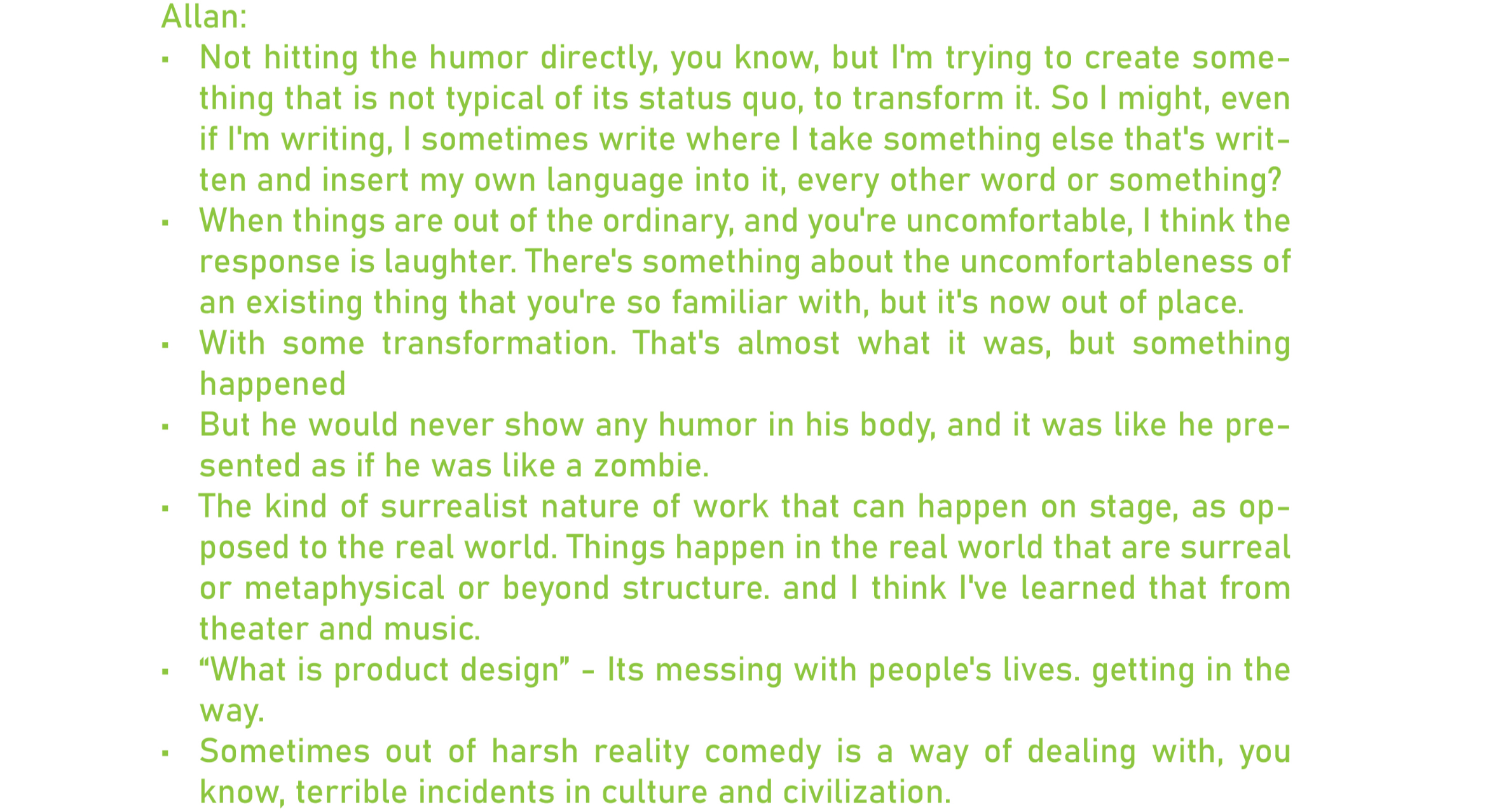
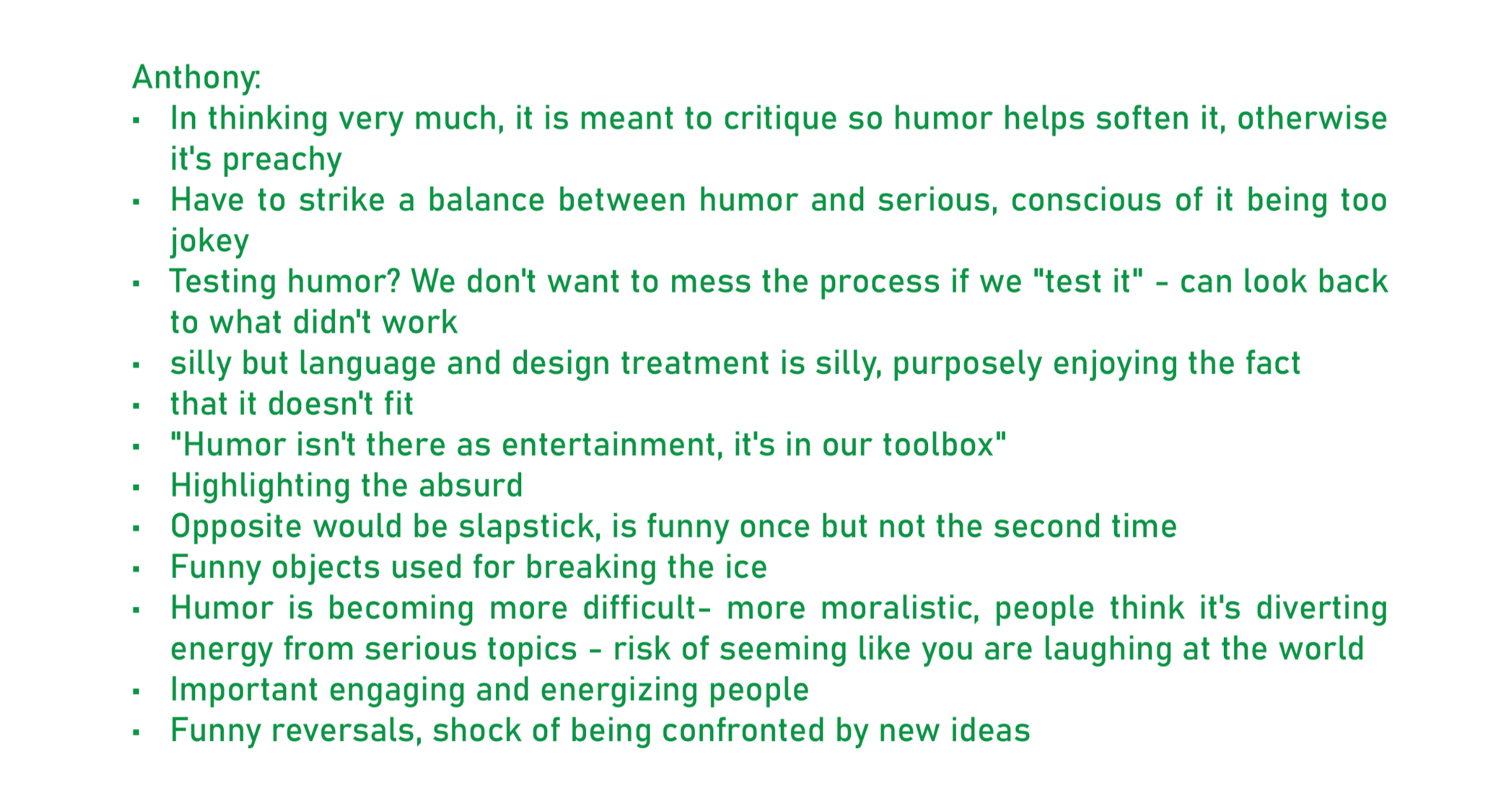


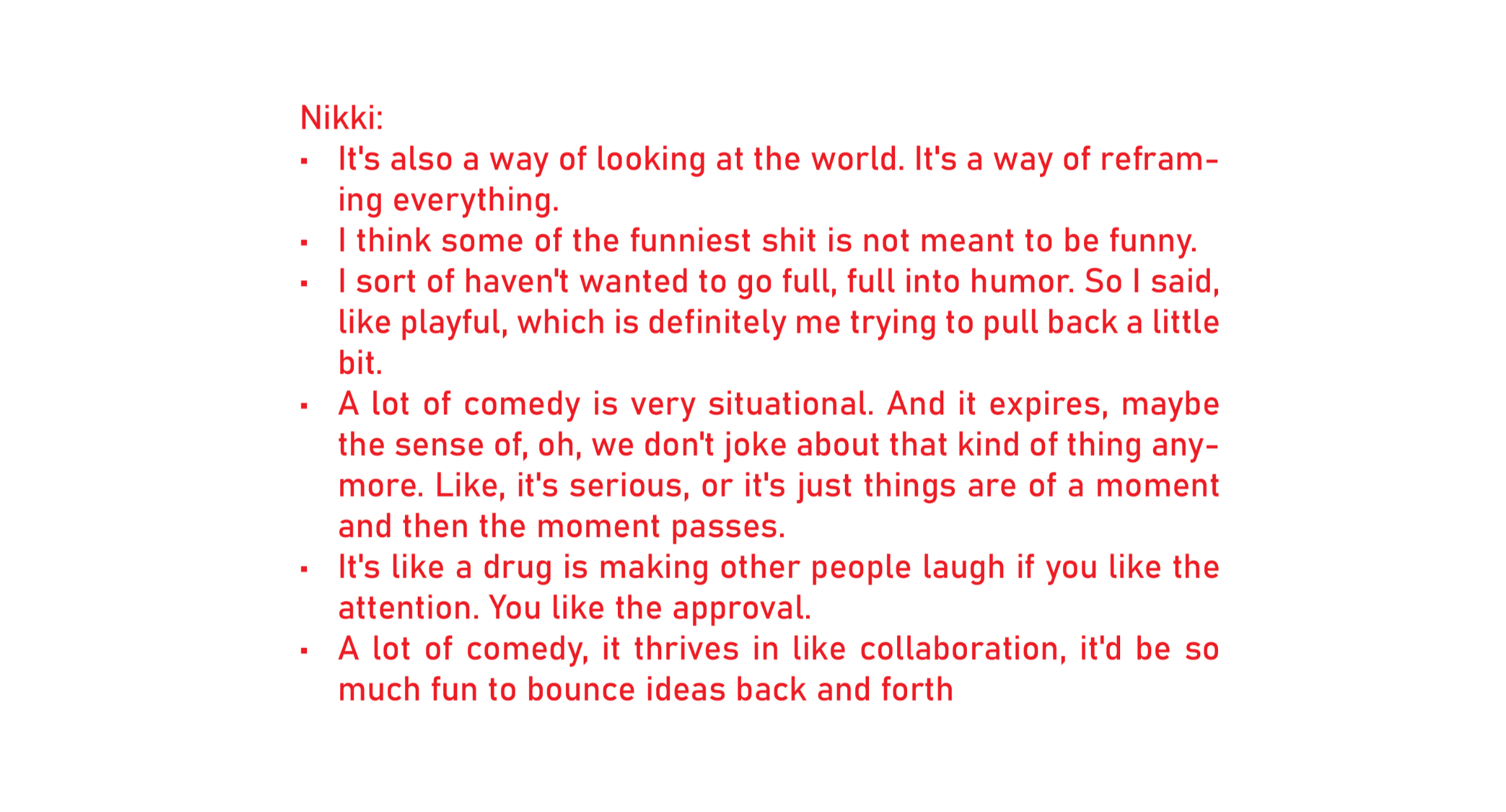
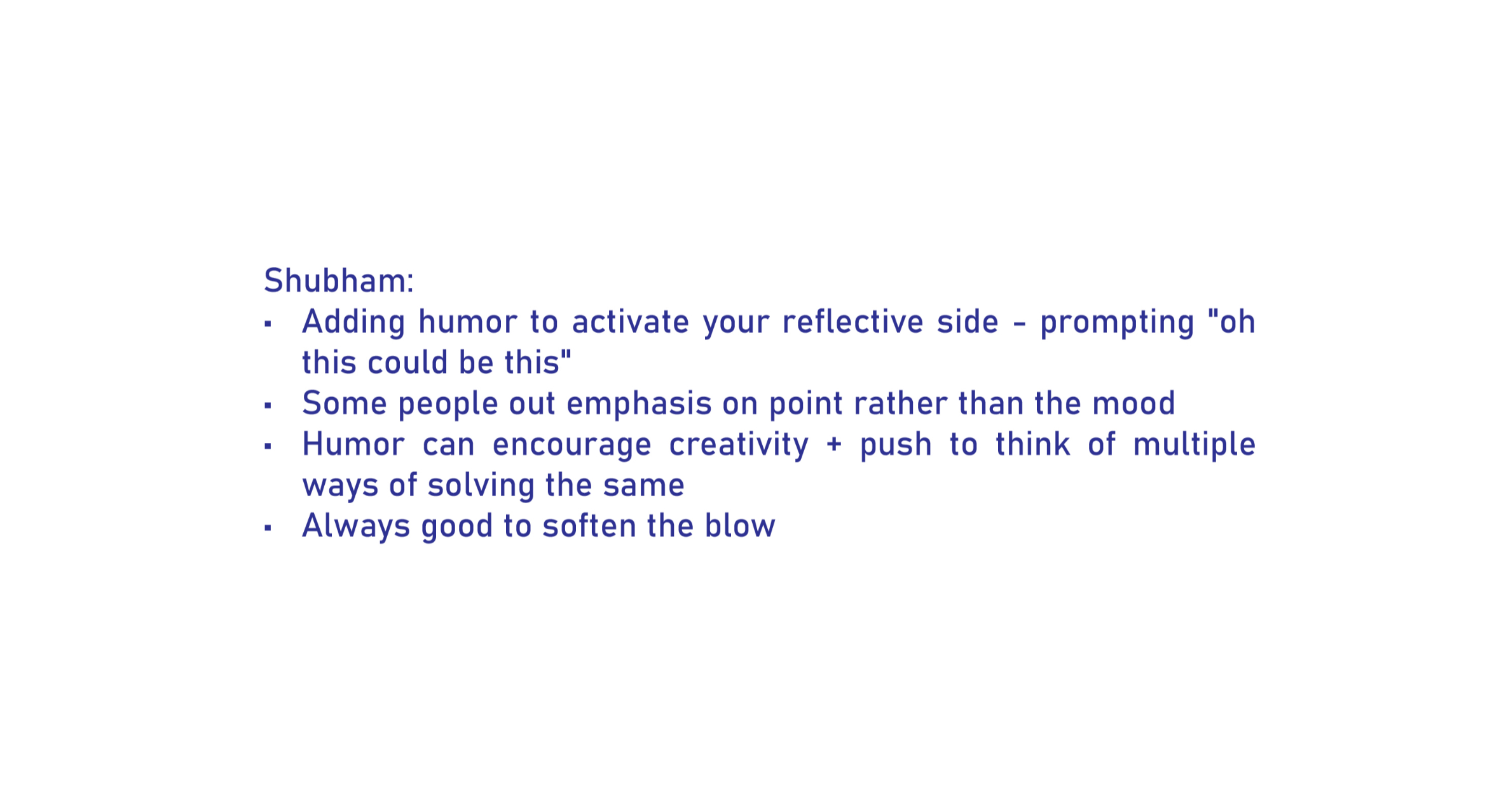

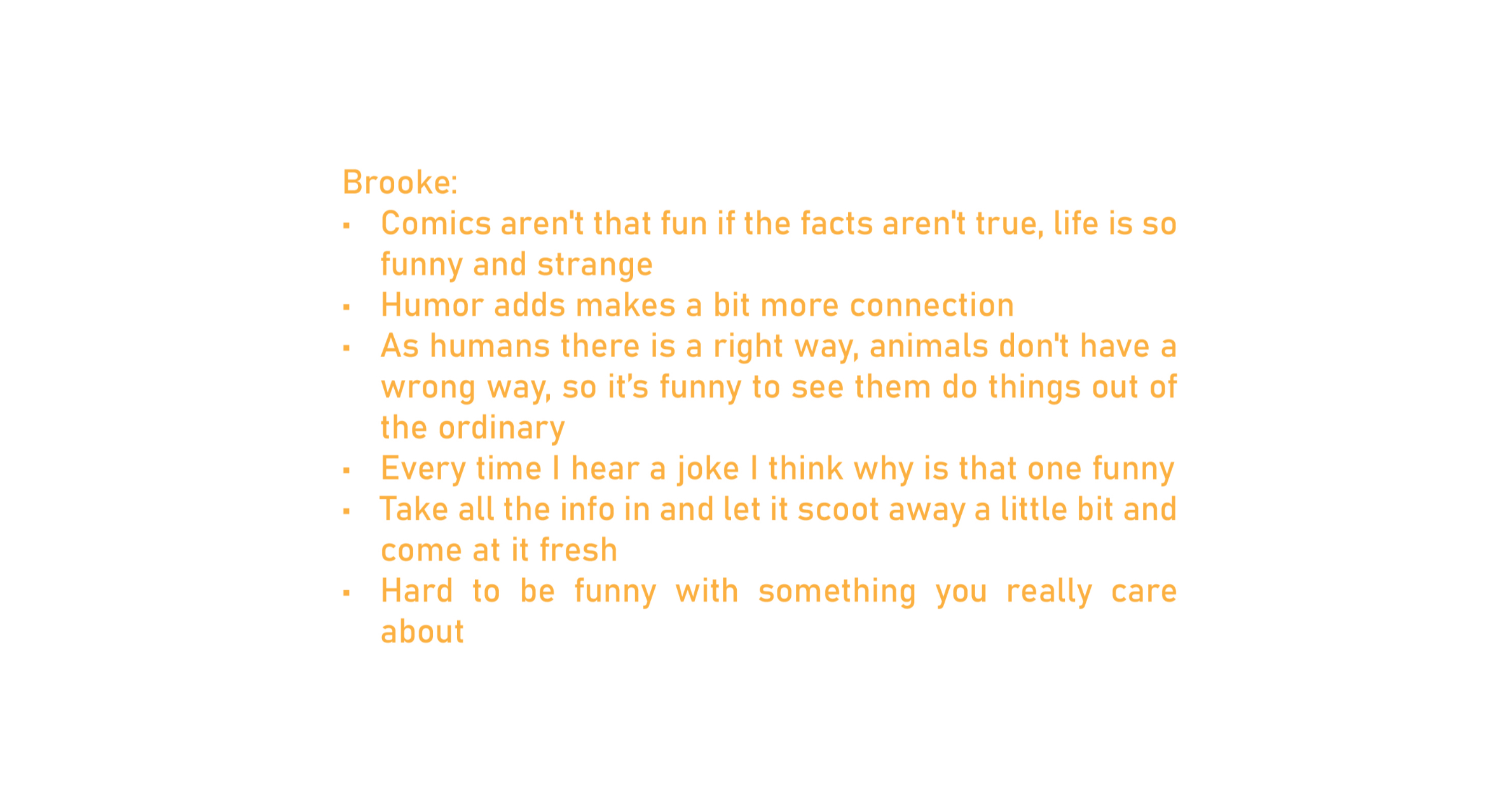
Insights Generated
Three designers, each with different design practices, one ethnomusicologist who uses music as a tool for climate activism, and one psychologist who researches intersections between gender, sexuality, race and technology. All of these people said, in their own contexts, that they use humor as an integral part of their work to talk about their work in a way that is more inviting.

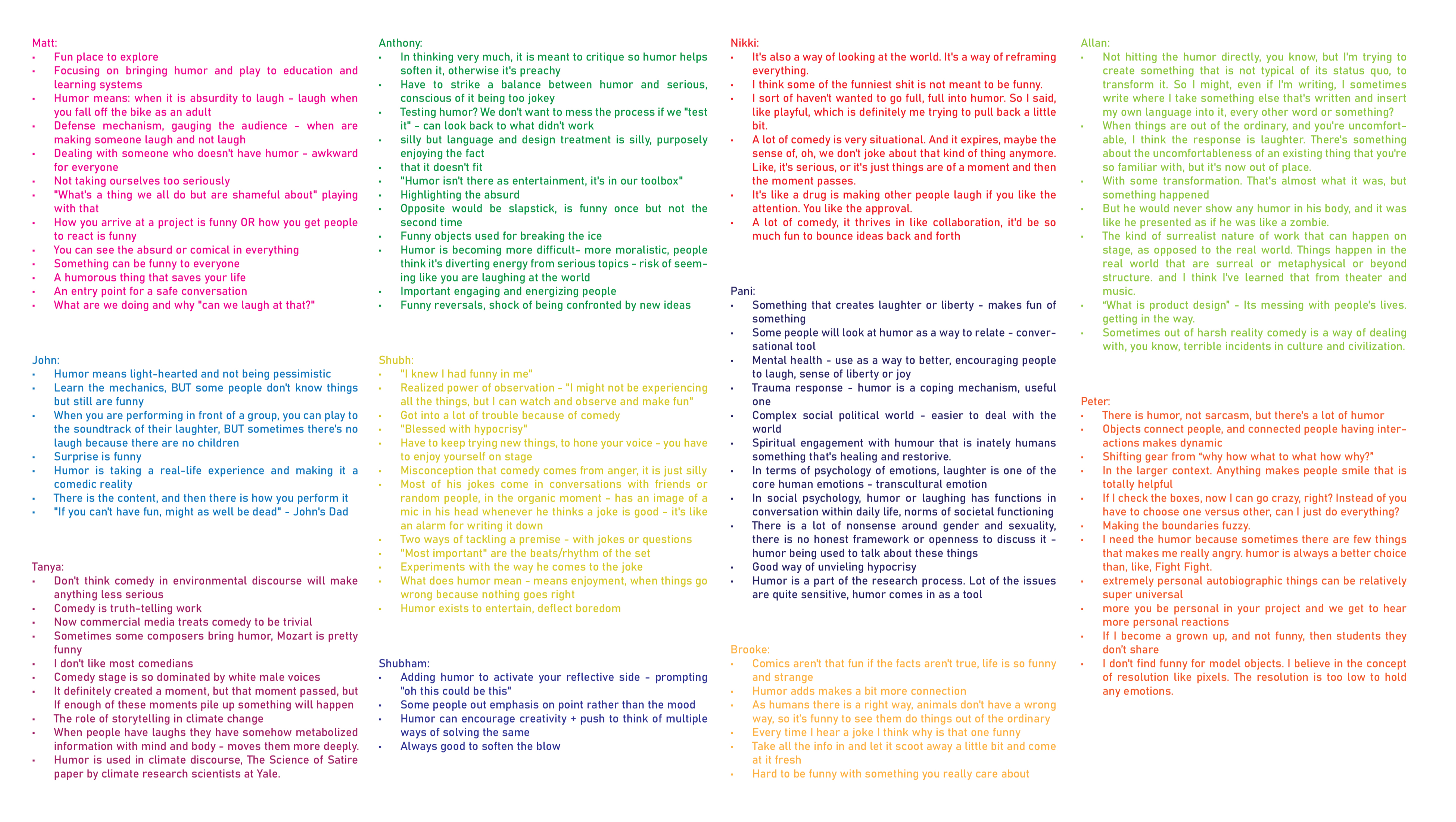
B. THE EXPERIMENT LAB
Experimenting the Limits of Humor
Three experiments were conducted and three research questions asked to study the intersection between humor and the constructed environments. Exploring the possibility of using humor as a material for physical interventions.
EXPERIMENT #0.01: Can a Funny Object, like Googly Eyes, When Applied to Other Objects, Pass on its Humor?
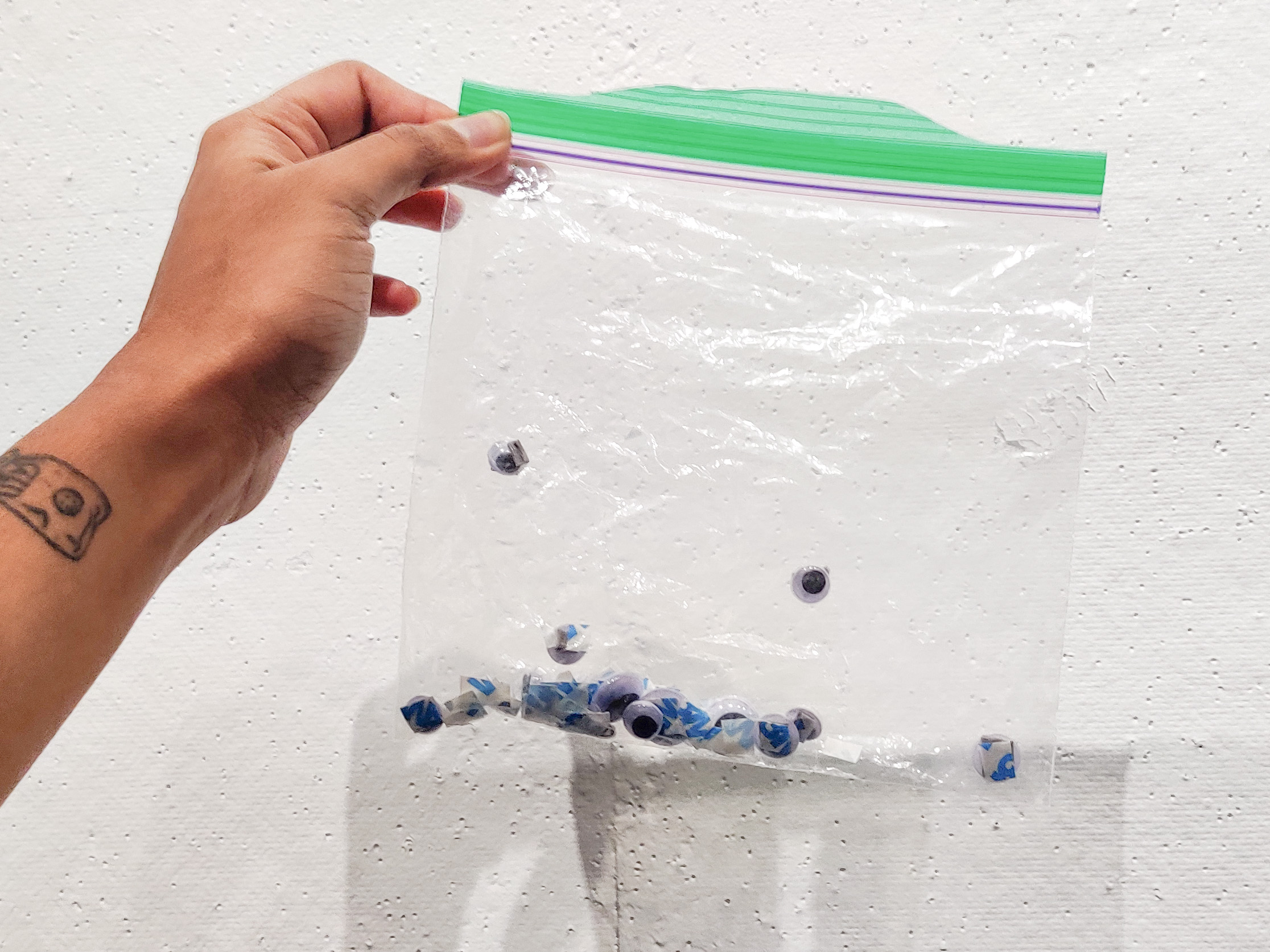

Googly Eyes = Commodity of Humor
The physicality of humor is played with by using the most obvious representation of it: Googly Eyes. Googly eyes were collected and applied to common household objects like sunscreen, a scented candle and a hand drill.
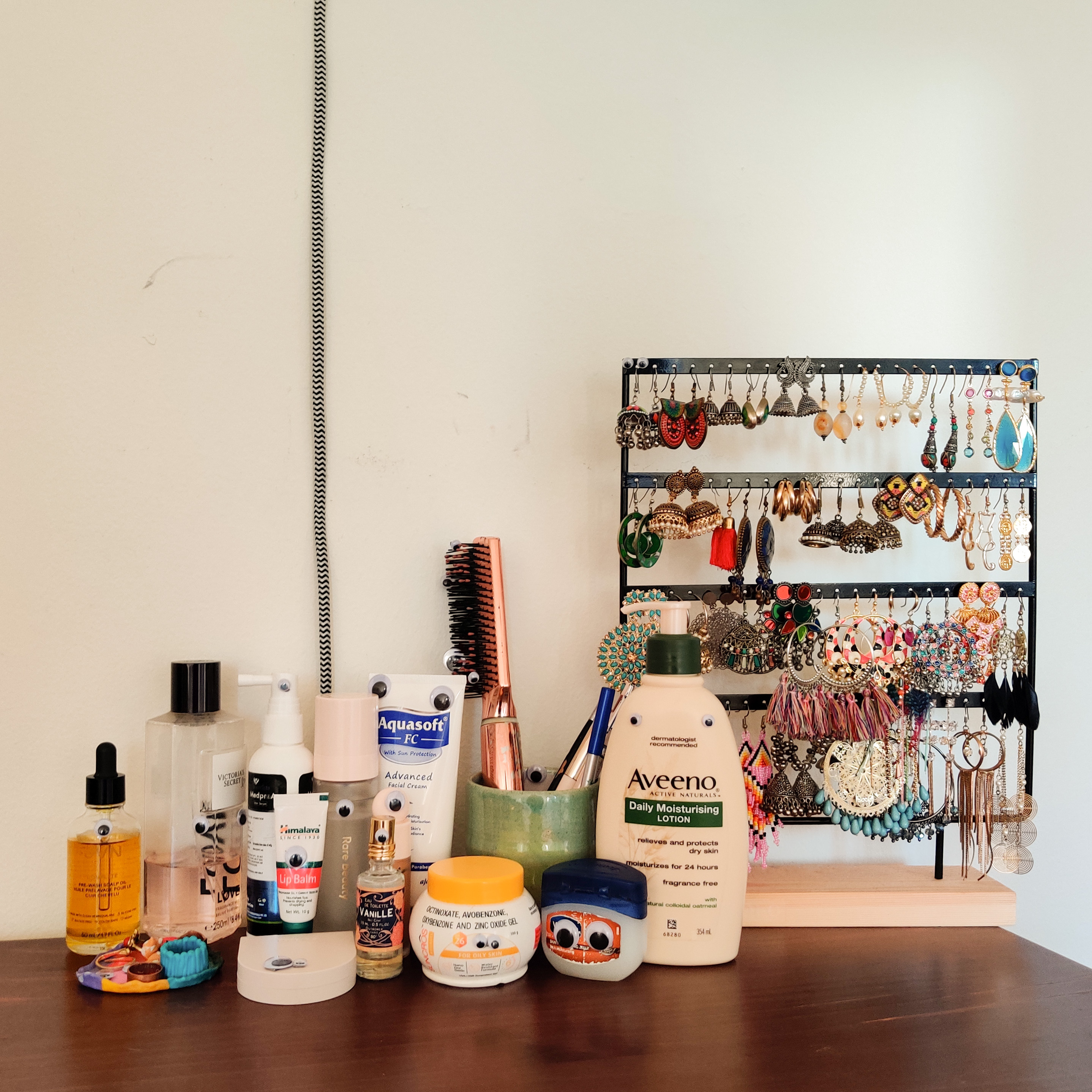



The Fragility of Humor
After living with these objects for over a week, one thing was clear: that humor is extremely fragile and time sensitive. The boundaries between funny and creepy become increasingly blurry, and almost non-existent, with more time. Freud’s Uncanny Valley was referred to understand the correlation between horror and comedy in other contexts.


EXPERIMENT
#0.02 : Is There an Obvious Joke?
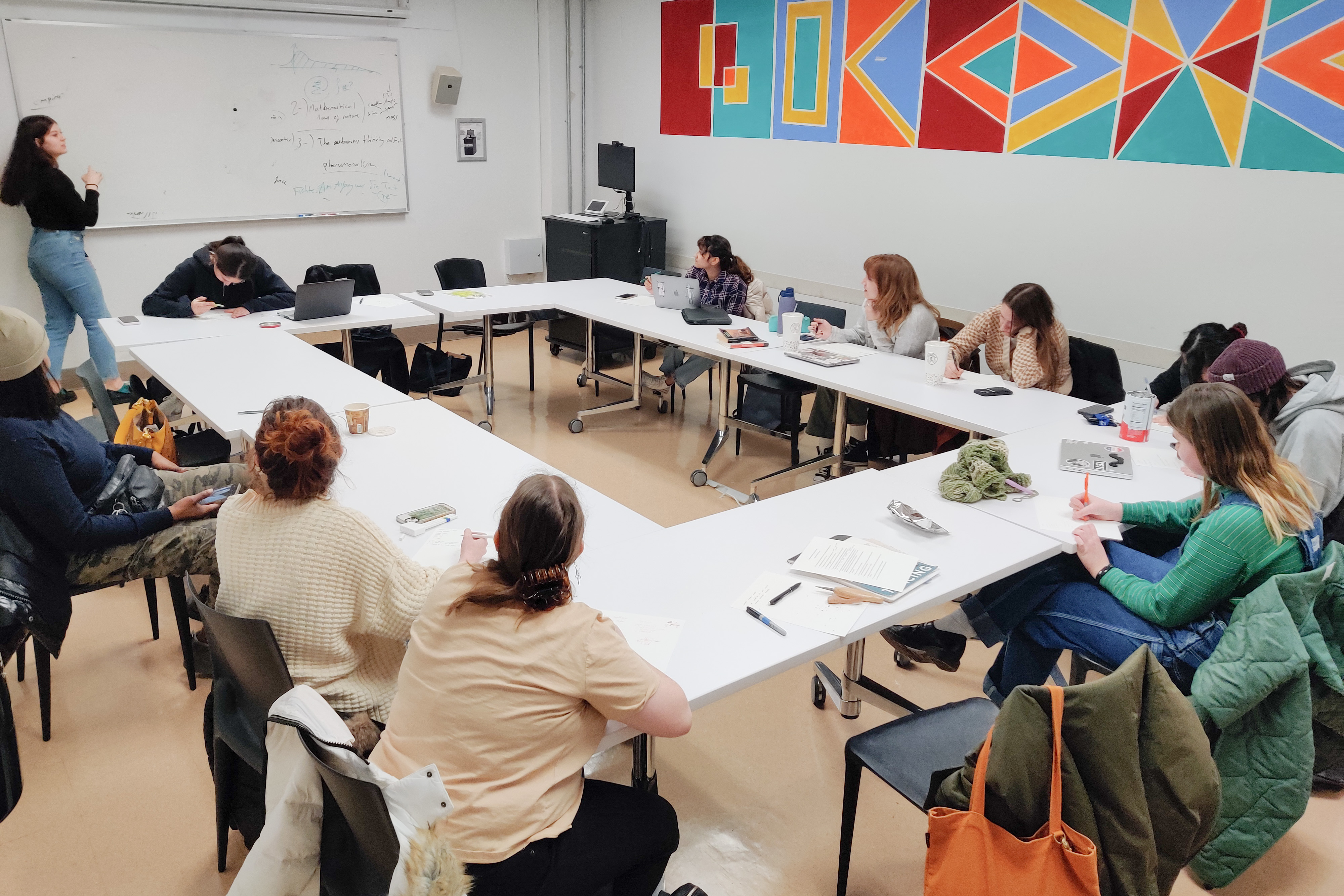
Prompting for Unlearning Object Functions
29 selected participants, mostly comedians or comedy writers, were given instructions to think of common objects like a toaster, stapler, or a measuring tape. Instructed to forget the functions of these objects, they had to think of 5 new names for them. After picking their favorite name, they were asked to write a 3-step instruction and draw a picture of this new object.

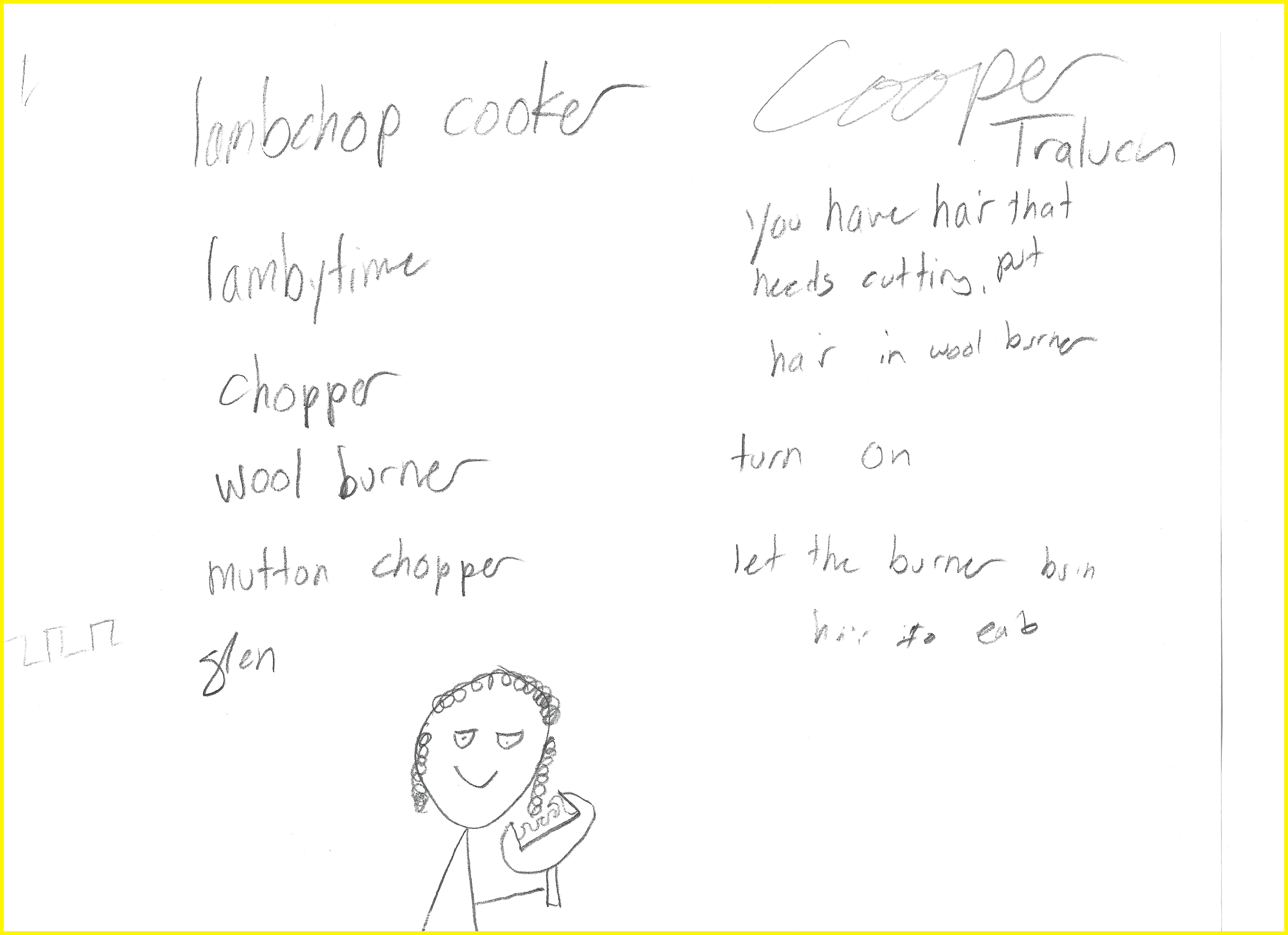
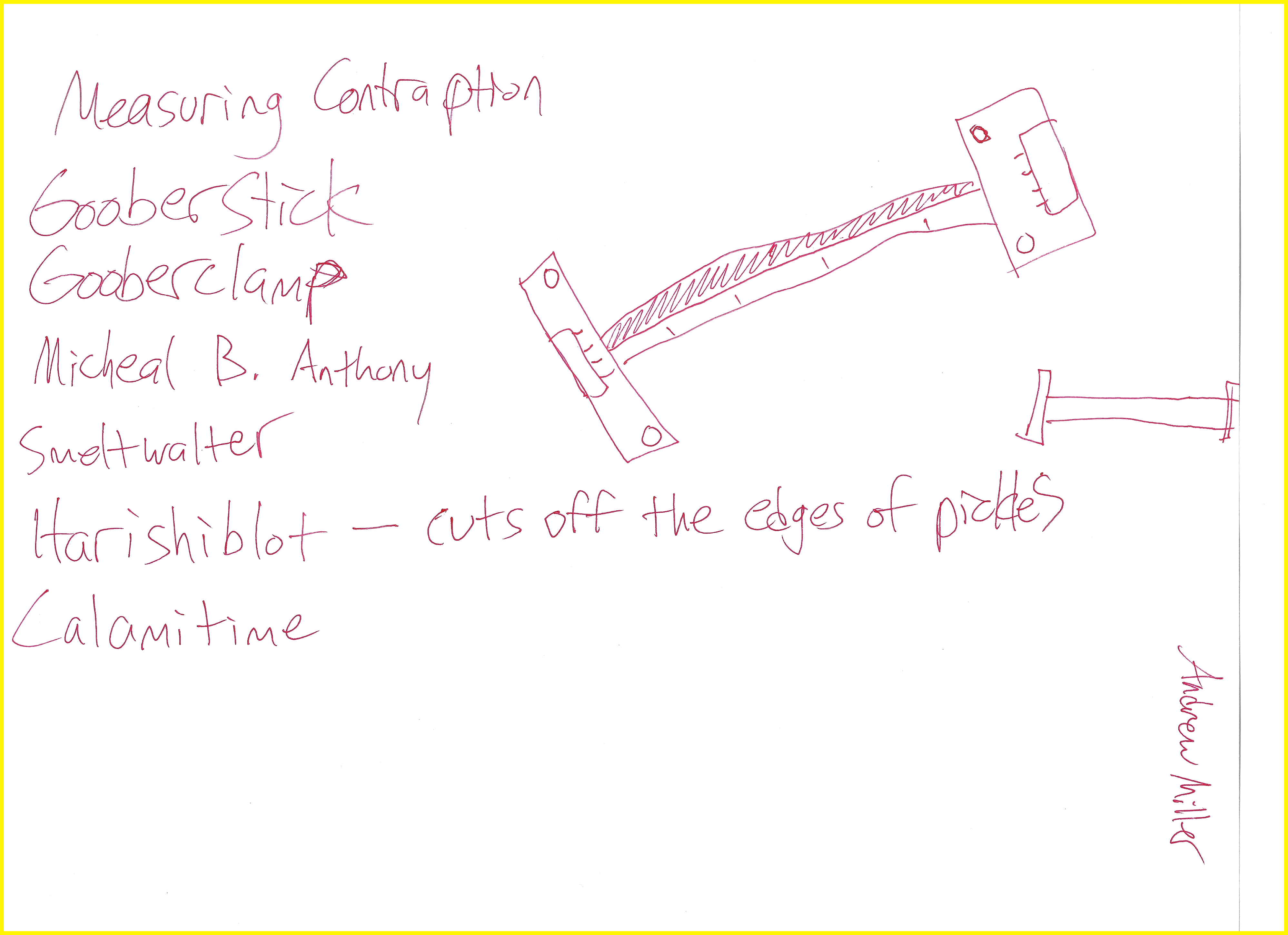




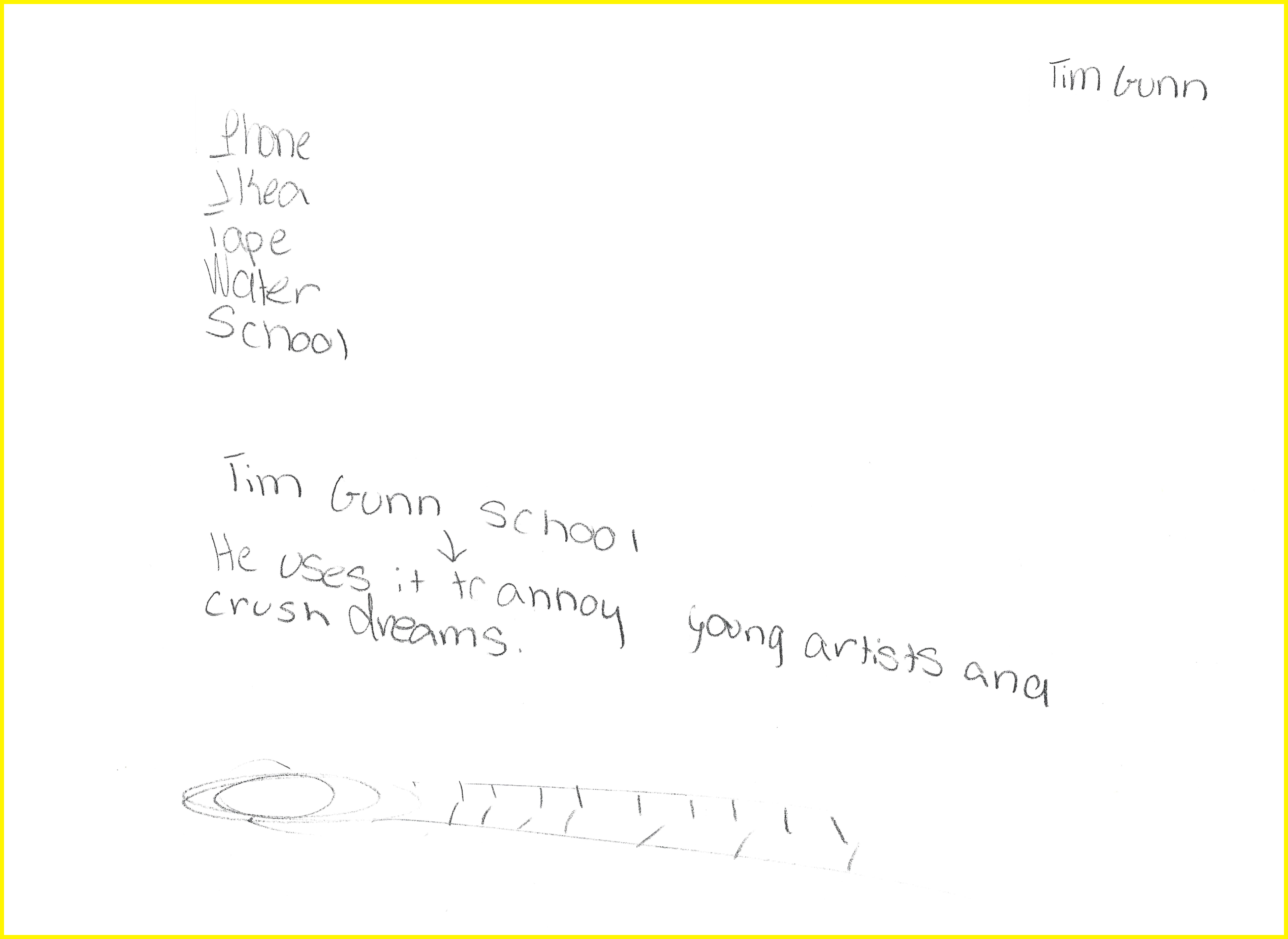
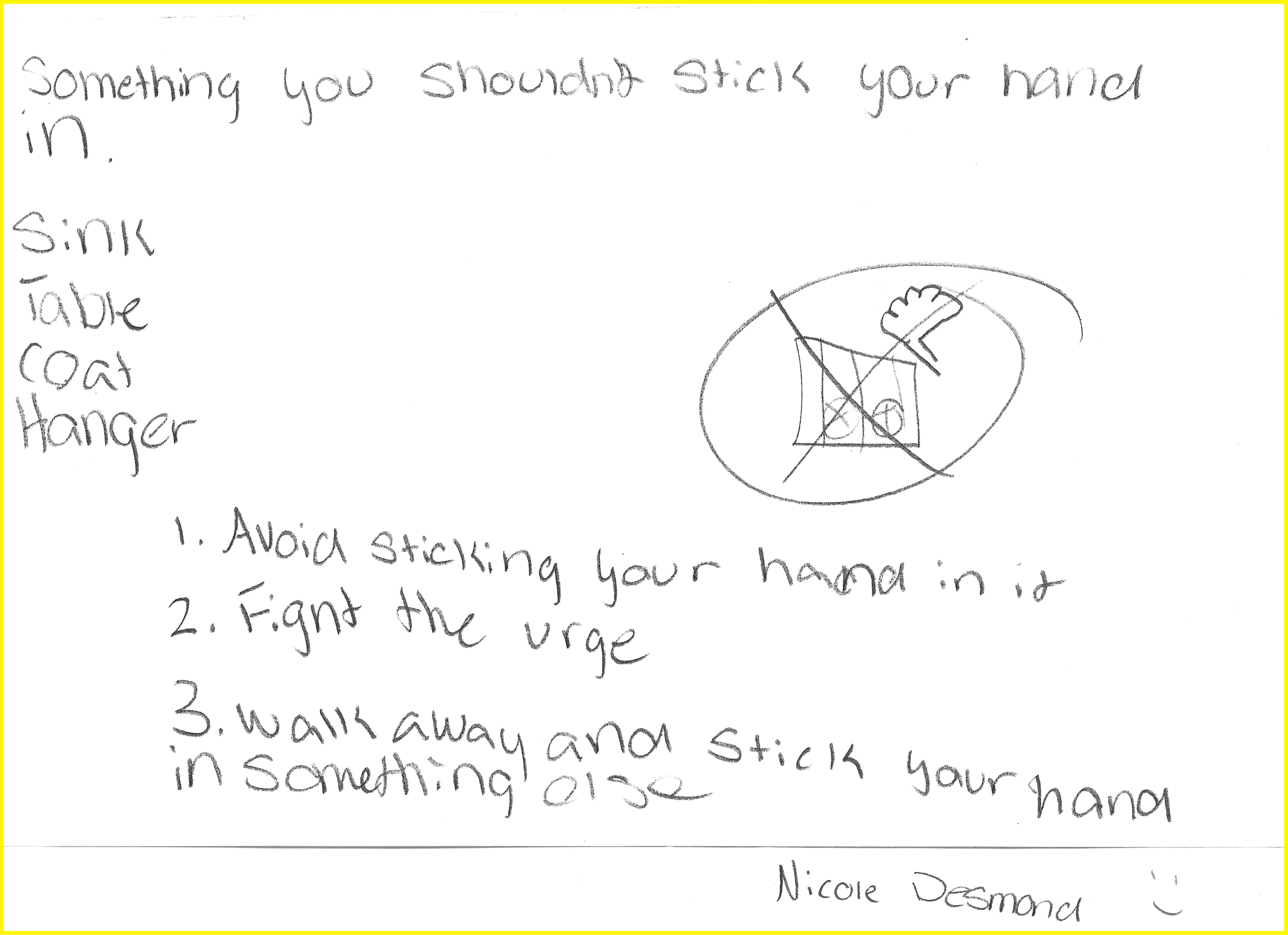
Results = Weird Objects
The exercise allowed people to take another look at the objects in their surroundings. They were forced to imagine the objects with humor in them, which is shown in their sketches. Post the exercise, we discussed some of the ideas, came up with commercials for them, and reflected on why these were funny.
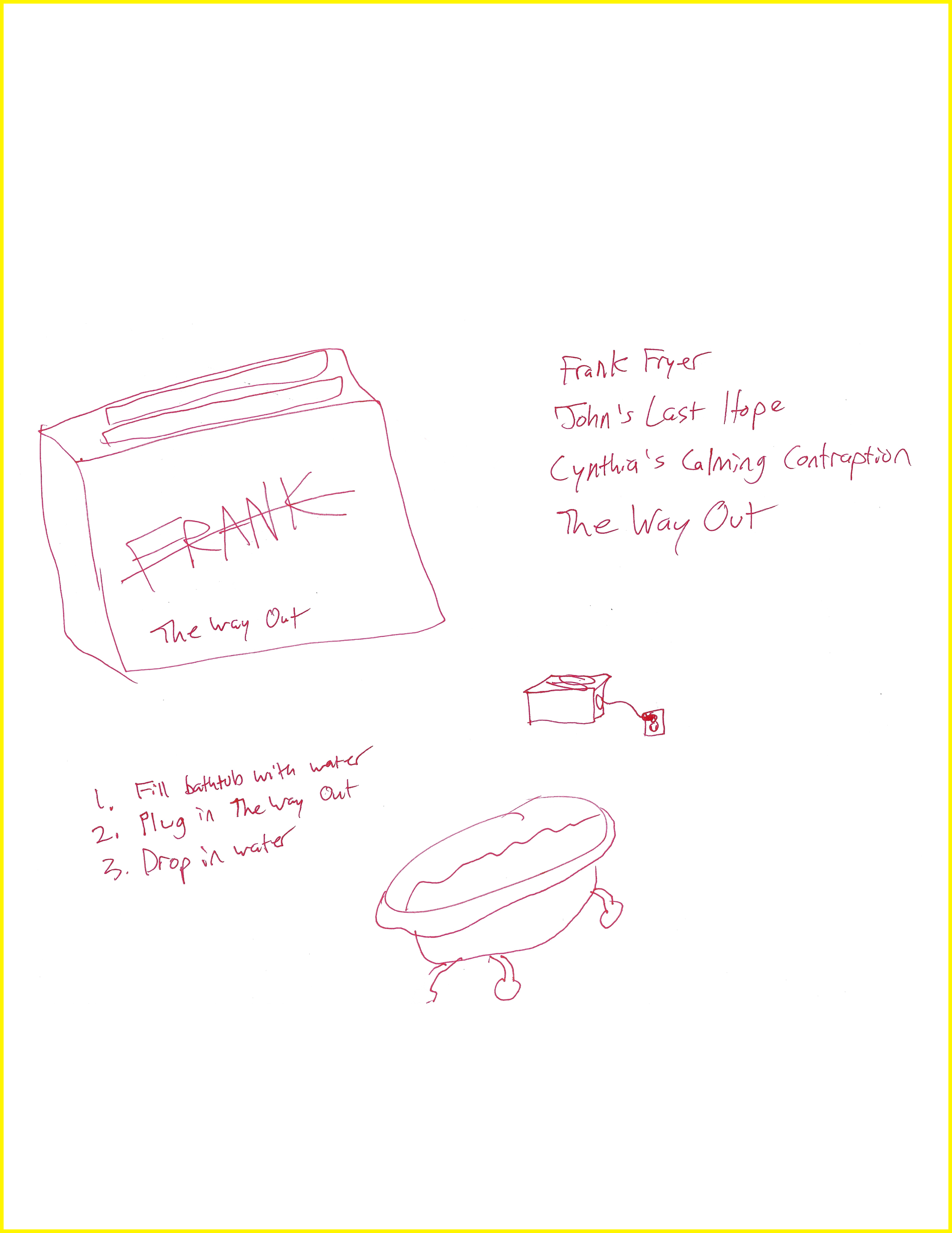


Three Toaster Bathbombs: A Common Thread
Weirdly enough, or obviously enough, three people wanted a Toaster to be a bathbomb killing machine. Clearly showing signs of what a shared sense of humor can look like, and the possibility of objects that can come out of that.
EXPERIMENT
#0.03 - Can We Use Stand-Up Comedy to Generate Design Prompts?
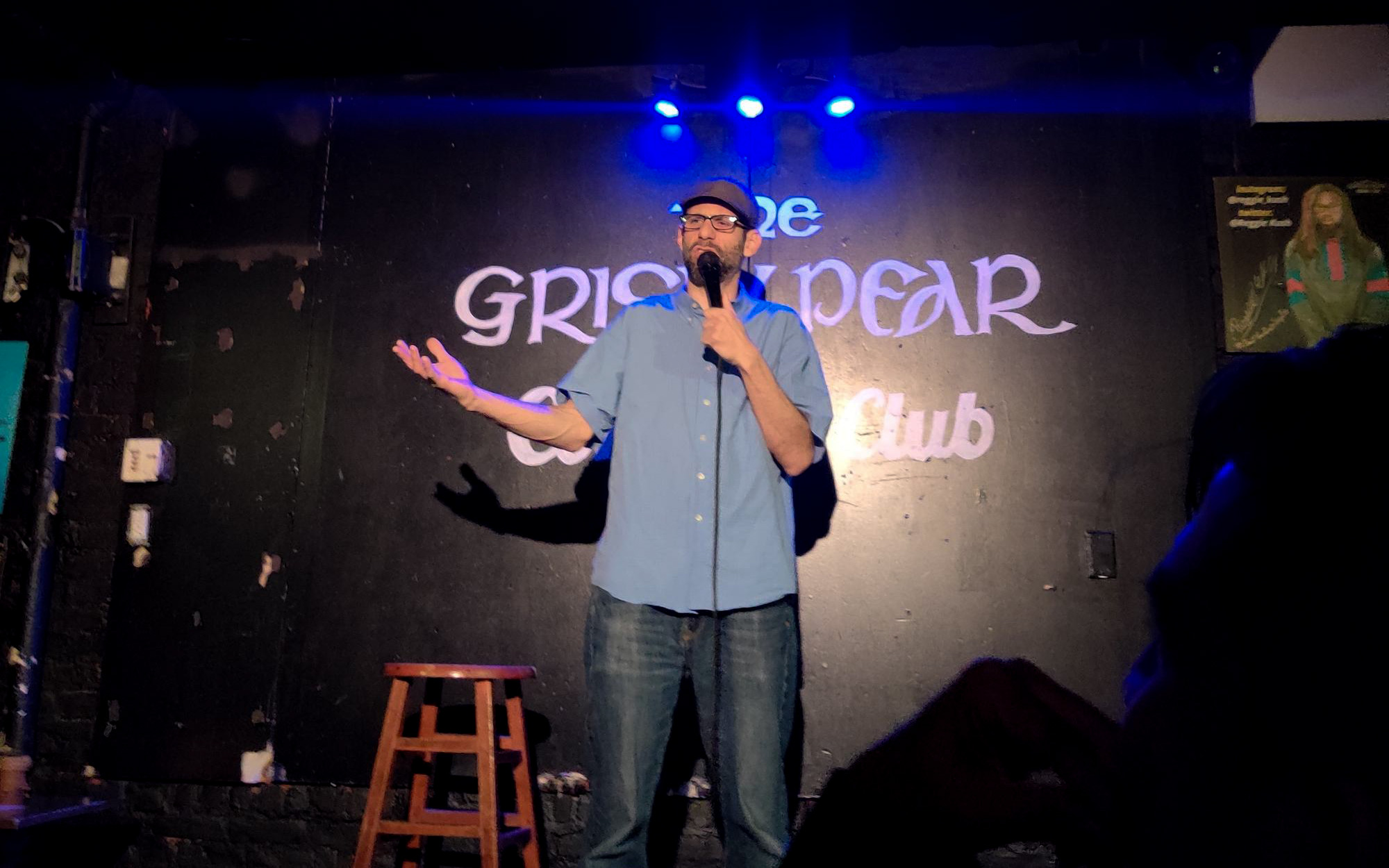
Taking Notes at Comedy Shows in New York City
Stand-up comedy is the most accessible form of humor. This experiment aimed to use stand-up comedy as a prompt-generator for design. Going to the comedy club with a notepad and a pen, automatically made the experience vastly different. Things like the laughter of the audience, the rhythm of the comedian, and the interruptions of the servers started to stand out. Here, comedy was a physical thing.

Formalized List of Prompts
Notes were made for every joke that had the potential to become a design prompt. Like when someone said that “going to the chiropractor is like being in a wrestling match with lively conversation”. From just one show, 16 such prompts were collected.
C. SOMATIC RESEARCH
15- Week Improv Comedy Class
Humor is a strong bodily experience, in both the creation and the enjoyment of it. If I claimed to understand humor, I had to put myself in the scene. Hence, a 15-week long improv acting class was taken at The New School. The class, taught by John Murphy, explored comedy through research, observation, games and acting exercises.

I actually took this class


Sculpting, Flowing, Flying
We learned how to move and how to use our bodies to perform the most mundane tasks, like sweeping the floor or saying hello, so exaggeratedly that it becomes funny. Through observing the idiosyncrasies of the people around us, we learned and adapted behaviors and quirks to build our scenes.



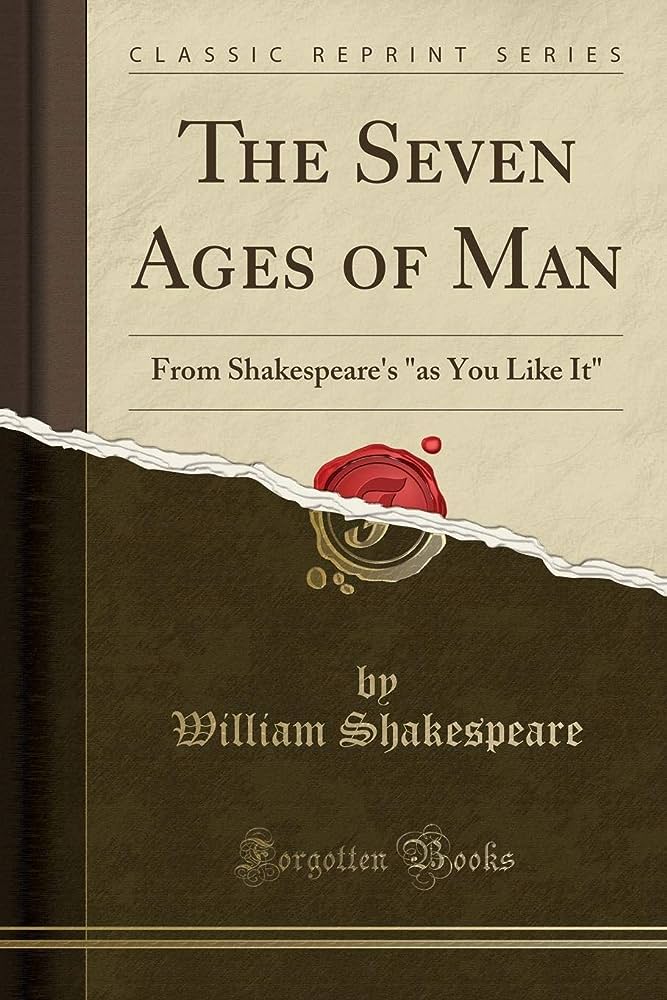
Chekhov & Shakespeare
Books of Michael Chekhov and William Shakespeare were studied. Two important acting principles included Chekhov’s The Psychological Gesture exercise, where the actor repeats the same sentence with different tempos and emotions, switching between fast to slow deliveries. And Shakespeare’s The Seven Ages of Man, through which we acted out people from different age groups, from a crying toddler to a grumpy grandpa. Learning how to take reality and turn it into a comedic reality.

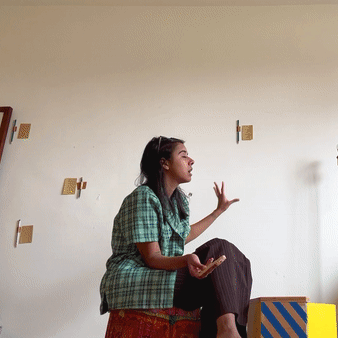

Bread Poet - Persona Building
From our learnings we created our own personas and characters. Through improv scenes performed in class, the persona slowly took shape by trial and error, seeing what works, and by reacting to the other actors’ personas. In the end, my persona was a poet who only writes her poetry on bread, but she always ends up eating it, which is her character flaw.
D. THE TOASTER TYPEWRITER
Research Through Design,
Christopher Frayling
In the 1960s Christopher Frayling proposed a new method of research, research through design. Design that intends to inform and to unlock the unknowns by making and doing. Design then truly becomes a tool, a process and a documentation for curiosity. It becomes a way of knowing. The making of the The Toaster-Typewriter was a key component of the research.

How to Stretch a Joke?
One of the iterations from the project Edible To-Do Lists got a very strong reaction. People found a lot of humor in it, and I wondered if I could stretch the joke. Watching the way that comedians are able to keep adding material to make their bits longer and funnier, this project is an attempt at making the bit longer. It takes the laser engraved bread and asks: What if this could be done using a manual machine?
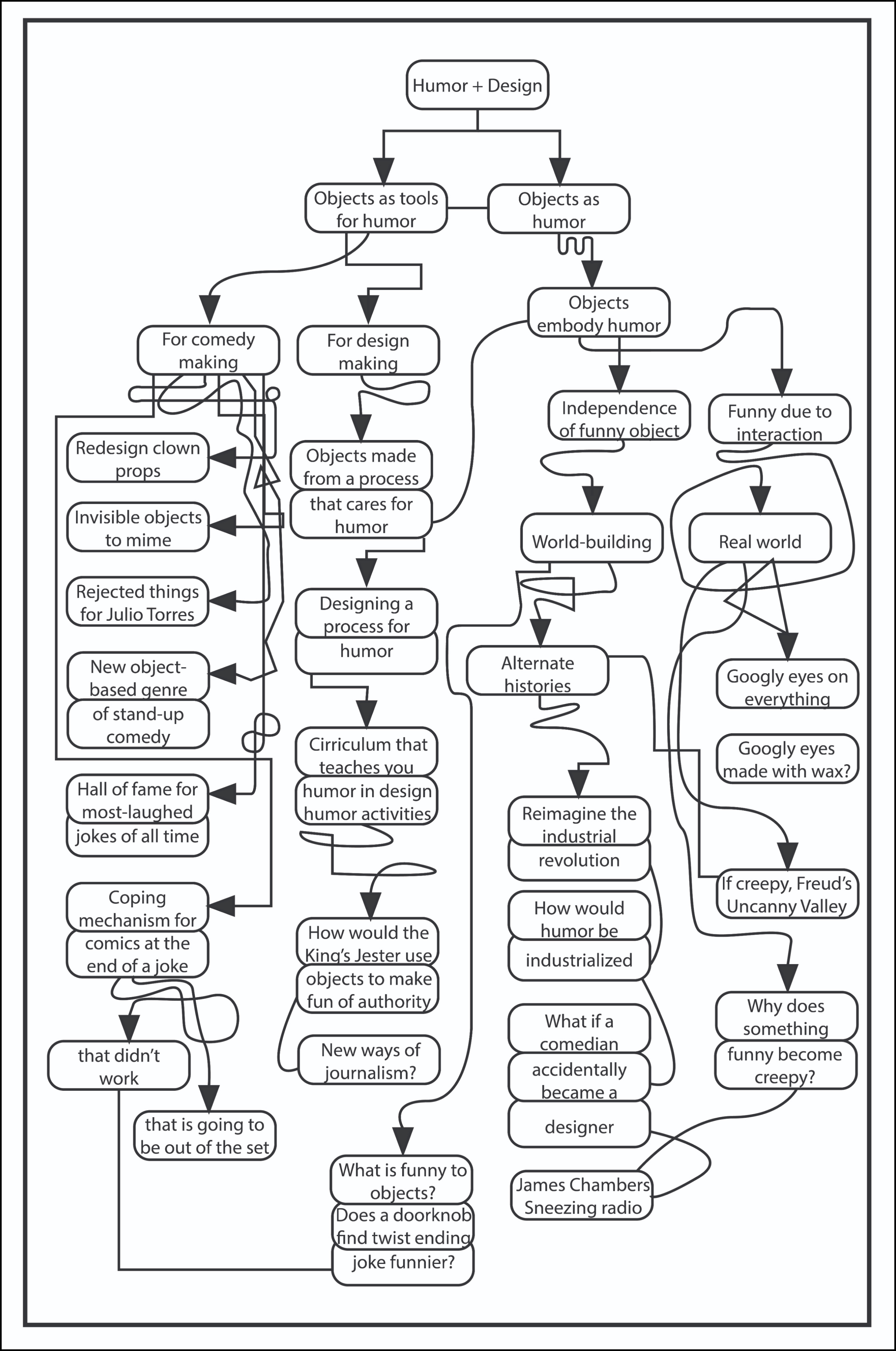
Intuitive Decision-Making
Learning from the improv class, this was a process of making quick and interesting decisions that had one purpose in mind: to make a toaster-typewriter that burns letters onto bread. The diagram shown here outlined all the possible routes for humor and design to merge.

Machines and More Electronics
A 50 year old typewriter was procured from a junkyard in Brooklyn and a $15 toaster was bought at Target. The toaster serves as a symbol for a machine that should never have really existed. It is so easy to replace a toaster with a lighter, a pan, or an open flame. The typewriter on the other hand is a magnificent device, but it is of no use today with all the technology that exists. How can these devices be reinvented to be useful again?
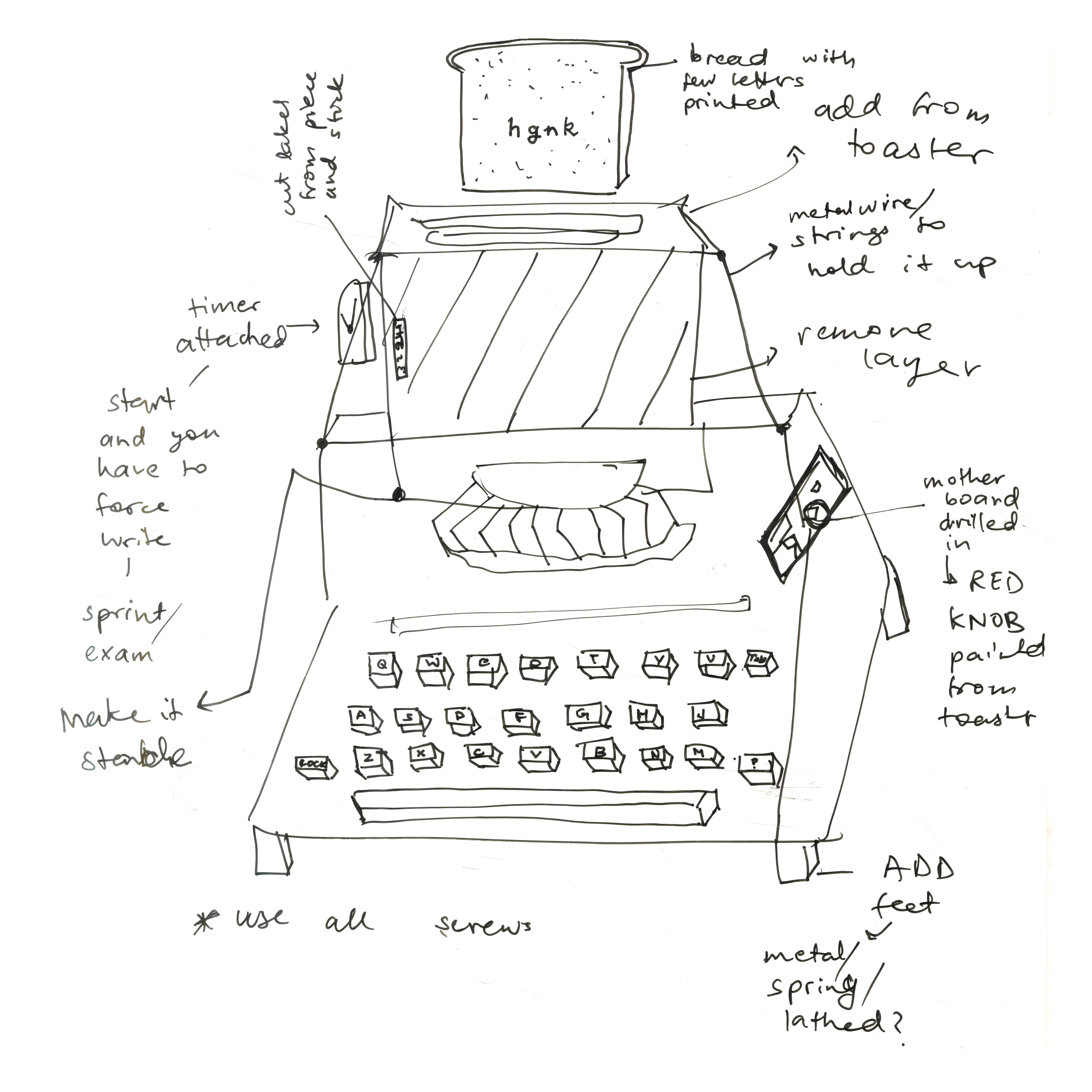
Construction Documents
Less of a plan for “making it work”, the construction document details all the things to be altered to make the visual of The Toaster-Typewriter. It cannot look more like a toaster or more like a typewriter, it has to be a third machine of its own personality. The functions of the typewriter were given to the toaster- like being able to move the page up, down, left and right. And visa versa, the typewriter could now toast bread.
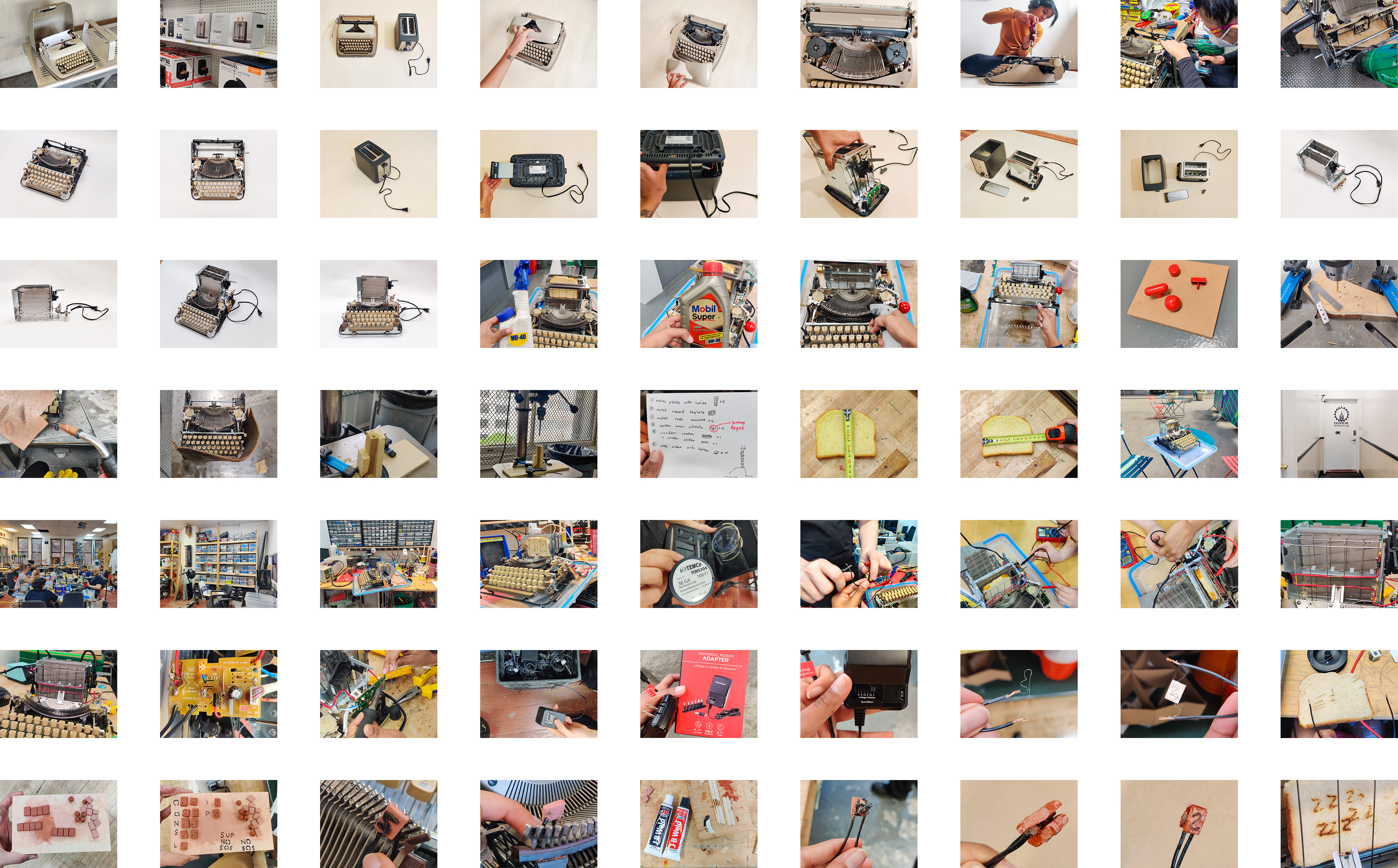
Disassembling, Misassembling, Tinkering, Deep Cleaning, Metalworking, Woodworking, Electric Circuiting, Spray Painting, Soldering, & Machine Testing
The process of making and engineering the machine to life was an endeavor of 8 weeks. Beginning by reverse engineering the
typewriter
and the
toaster
to remove excess material, followed by a deep cleaning of the old typewriter to get rid of dirt and rust to make it type again. A custom locking mechanism and castor wheels were welded and screwed in. Various ways of heating up the wire to burn letters were tested.
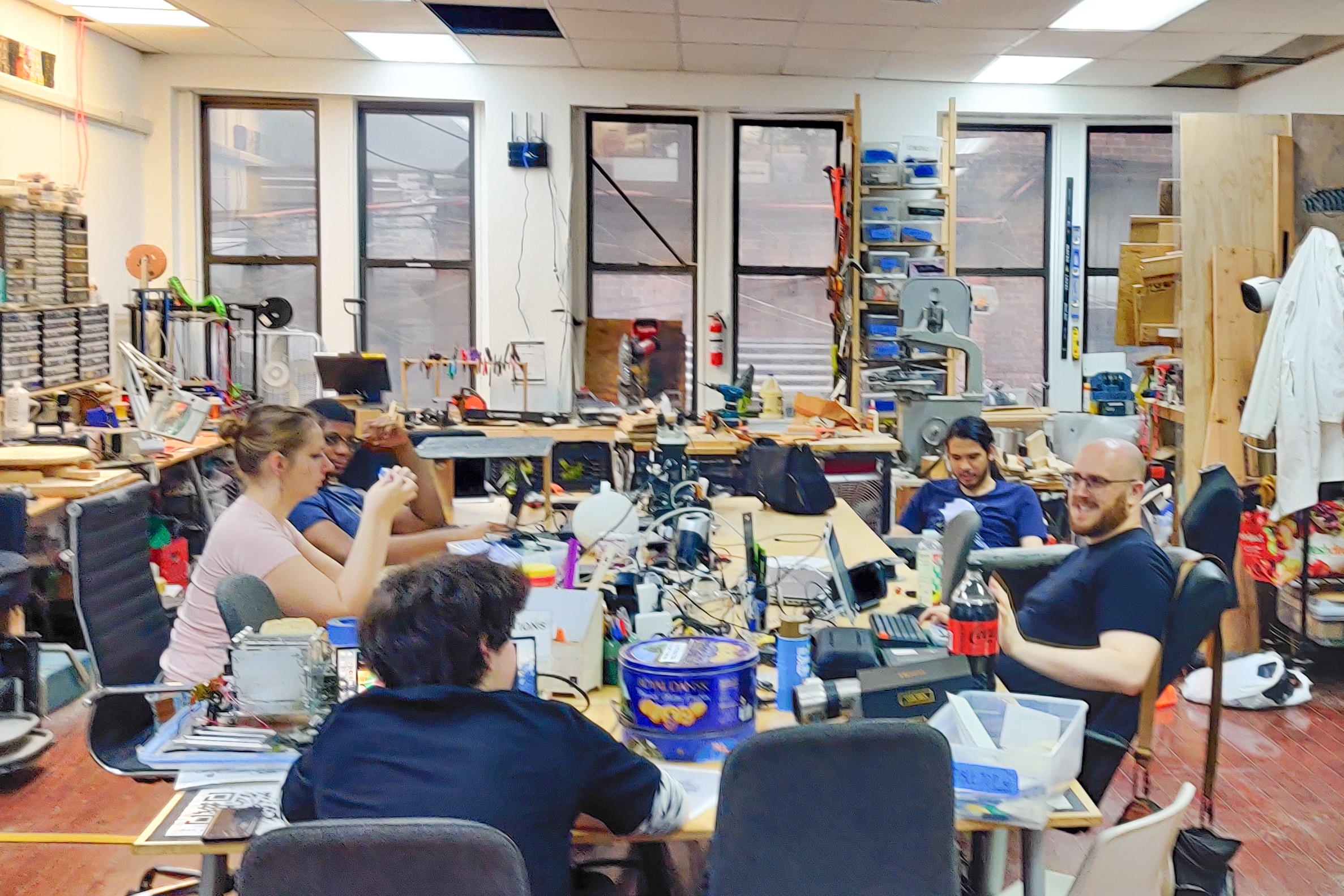
Collaborating with Engineers
To actually make it work and burn letters on bread, I collaborated with electrical engineers from Hack Manhattan, a maker’s space in NYC. We learned from the simple mechanisms used in a wire foam cutter. A conductive copper wire was shaped into the alphabet of choice (this typewriter has S, O, and U) which is connected on both ends to a transformer power adapter, and plugged into the wall. The mechanism worked on its own, but to be attached to the all-metal typewriter, it needed additional custom clay letterheads to be built to protect from electrocution.

The Toaster-Typewriter in Action
The thrill of typing your first letter onto bread using The Toaster-Typewriter cannot be described in words. This new extraordinary of eating text opens up the world to a new form of communication and a new form of cooking. What’s so funny about bread? Through this machine, a global staple food is made funny by completely diminishing its value by placing text on it, bringing into view the privileged market that new technologies usually cater to.







Humor as a Design Practice

A Serious Endeavor
Circling back to the most important outcome of this project. The ten commandments were created to become a framework and serve as a guide for designers looking to bring more humor into their work. It rethinks the Ten Principles for Good Design by Dieter Rams, and takes design out of the context of the industry. Laughter is contagious, it has the potential to break down barriers and bring people together. By using humor in design, we can create a more engaging and interesting world.

From the first 25 people to touch The Toaster-Typewriter
The Research Continues
This research on humor is ongoing. I am continuously conducting micro experiments to test the humor in the everyday surroundings. Both, research and making, will be pursued through collaborations with other designers and non-designers. The form shown here is a waiting list filled out by people eager to have their texts or jokes typed onto bread. I intend on printing all of them.
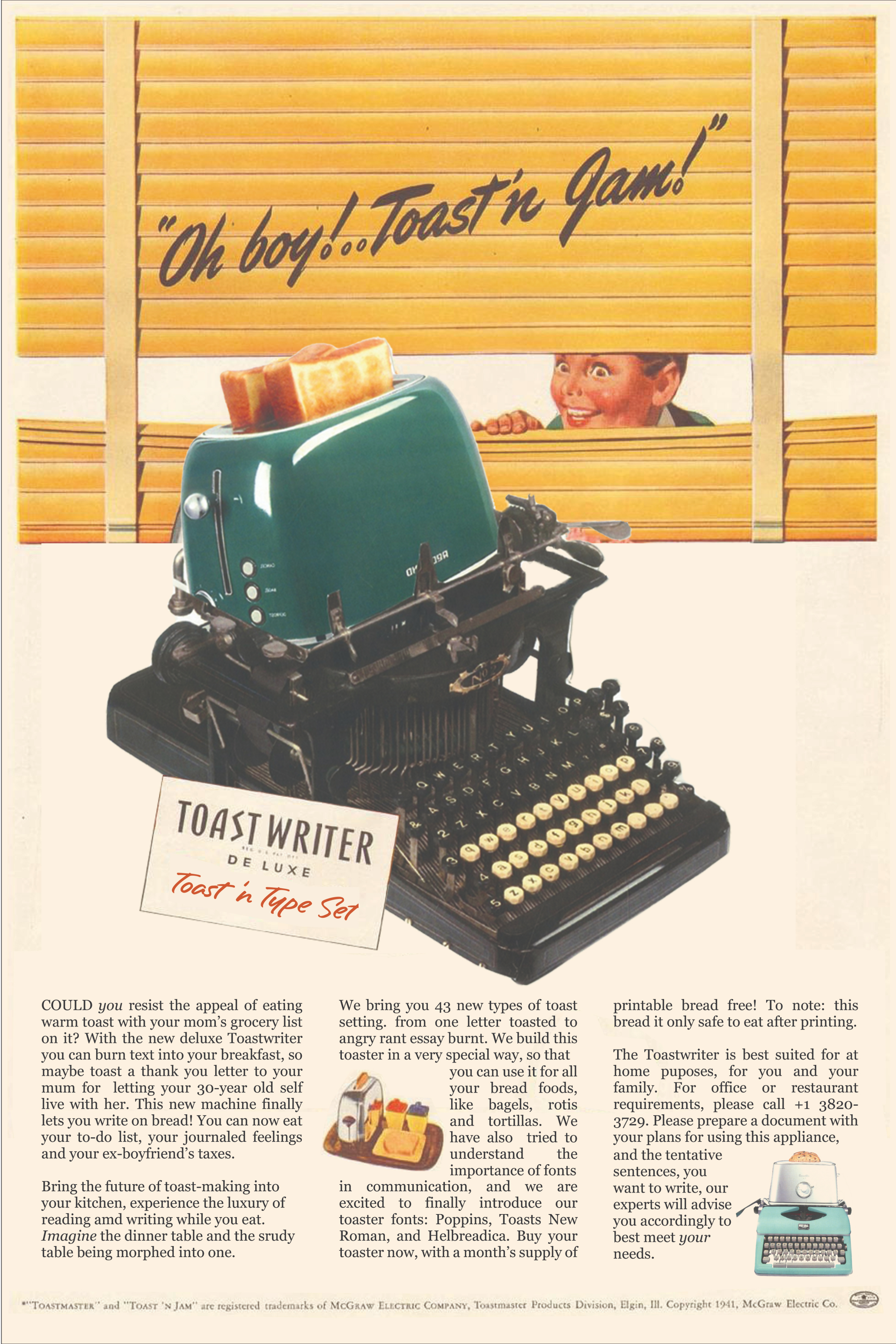
Humor Futures (or Pasts)
This project outlines how we can embed humor in our design process. This poster creates an alternate history where The Toaster-Typewriter existed decades earlier, forcing us to imagine: What would the world look like in the present if this was our past? This type of speculation is what this project was born out of and what this project aims to inspire.

REFERENCES
Research conducted under the guidance of thesis advisor, somatic researcher and professor- Ari Elefterin. Thank you for your unwavering support.
Special thanks to all the interviewees for your collective insights on humor: Allan Wexler, Anthony Dunne, Brooke Barker, John Murphy, Matthew Leabo, Nikki Bregman, Pani Farvid, Peter Sim, Shubh Nanda, Shubham Jumde, Tanya Kalmanovitch.
Gratitute to all the participants from The New School’s The Comedy Club Club for your hilarious sketches.
Thank you technicians at the E4 metal and wood shops: Ting Lau, Damien Vera, Kat Nash, and Eva Warne.
Thank you Hack Manhattan for welcoming me into your space, and especially Trek for all your feedback.
Works Cited:
Apatow, Judd. I Found This Funny. San Francisco: McSweeney’s Books, 2011.
Apatow, Judd. Sick in the Head: Conversations About Life and Comedy. London: Duckworth Overlook, 2017.
Barker, Brooke. How Do Meerkats Order Pizza? S.l.: Simon & Schuster Books, 2023.
Birbiglia, Mike. “Mike Birbiglia's Working It Out”. Working It Out. 18 Episodes. Podcast audio, https://www.birbigs.com/working-it-out-pod
Chekhov, Michael, and Mel Gordon. On the Technique of Acting. New York: Harper Perennial, 1991.
Comedians in Cars Getting Coffee with Jerry Seinfeld. 23 Episodes over 6 seasons, First aired, Crackle; 2012.
Dunne, Anthony, and Fiona Raby. Speculative Everything: Design, Fiction, and Social Dreaming. MIT PRESS, 2013.
Gill, Kanan, and Manik D'Silva. “No New Notifications”. No New Notifications Podcast. 27 Episodes. Podcast audio, https://nonewnotifications.com/
Martin, Steve. Born Standing Up: A Comic’s Life. London: Pocket, 2008.
Mathew, Abish. “Journey of a Joke”. Son of Abish. 16 Episodes. Podcast audio. https://youtu.be/BTouiD4arrk
Perec, Georges. Species of Spaces and Other Pieces: Essays. London: Penguin Books, 1997.
Rothenstein, Julian, and Andreĭ Kurkov. Everyday Play: A Campaign Against Boredom. St. Lawrence Terrace, London: Redstone Press, 2022.
Rubin, Julia. “What’s so Funny?” Vox, December 19, 2022. https://www.vox.com/the-highlight/23495150/whats-so-funny.
Rubin. Susan Goldman. Toilets, Toasters & Telephones. Harcourt Children's Books,1998.
Shakespeare, William. Seven Ages of Man: From Shakespeare’s “As You Like It.” Nabu Press, 2010.
Shepard, Dax, and Monica Padman. “Armchair Expert with Dax Shepard”. Armchair Expert. 5 episodes. Podcast audio. https://armchairexpertpod.com/
Thwaites, Thomas. The Toaster Project: Or a Heroic Attempt to Build a Simple Electric Appliance from Scratch. New York: Princeton Architectural Press, 2011.
Volpe, Allie. “What’s so funny?”. Vox Unexplainable. Podcast audio, March 22, 2023. https://open.spotify.com/episode/0OM48F29XocyCRl8nUD8sw?si=mHiUJwFBQhKYQ9qSwFZTVA
Watsky, George. How to Ruin Everything: Essays. NY, NY: Plume, 2016.
Special thanks to all the interviewees for your collective insights on humor: Allan Wexler, Anthony Dunne, Brooke Barker, John Murphy, Matthew Leabo, Nikki Bregman, Pani Farvid, Peter Sim, Shubh Nanda, Shubham Jumde, Tanya Kalmanovitch.
Gratitute to all the participants from The New School’s The Comedy Club Club for your hilarious sketches.
Thank you technicians at the E4 metal and wood shops: Ting Lau, Damien Vera, Kat Nash, and Eva Warne.
Thank you Hack Manhattan for welcoming me into your space, and especially Trek for all your feedback.
Works Cited:
Apatow, Judd. I Found This Funny. San Francisco: McSweeney’s Books, 2011.
Apatow, Judd. Sick in the Head: Conversations About Life and Comedy. London: Duckworth Overlook, 2017.
Barker, Brooke. How Do Meerkats Order Pizza? S.l.: Simon & Schuster Books, 2023.
Birbiglia, Mike. “Mike Birbiglia's Working It Out”. Working It Out. 18 Episodes. Podcast audio, https://www.birbigs.com/working-it-out-pod
Chekhov, Michael, and Mel Gordon. On the Technique of Acting. New York: Harper Perennial, 1991.
Comedians in Cars Getting Coffee with Jerry Seinfeld. 23 Episodes over 6 seasons, First aired, Crackle; 2012.
Dunne, Anthony, and Fiona Raby. Speculative Everything: Design, Fiction, and Social Dreaming. MIT PRESS, 2013.
Gill, Kanan, and Manik D'Silva. “No New Notifications”. No New Notifications Podcast. 27 Episodes. Podcast audio, https://nonewnotifications.com/
Martin, Steve. Born Standing Up: A Comic’s Life. London: Pocket, 2008.
Mathew, Abish. “Journey of a Joke”. Son of Abish. 16 Episodes. Podcast audio. https://youtu.be/BTouiD4arrk
Perec, Georges. Species of Spaces and Other Pieces: Essays. London: Penguin Books, 1997.
Rothenstein, Julian, and Andreĭ Kurkov. Everyday Play: A Campaign Against Boredom. St. Lawrence Terrace, London: Redstone Press, 2022.
Rubin, Julia. “What’s so Funny?” Vox, December 19, 2022. https://www.vox.com/the-highlight/23495150/whats-so-funny.
Rubin. Susan Goldman. Toilets, Toasters & Telephones. Harcourt Children's Books,1998.
Shakespeare, William. Seven Ages of Man: From Shakespeare’s “As You Like It.” Nabu Press, 2010.
Shepard, Dax, and Monica Padman. “Armchair Expert with Dax Shepard”. Armchair Expert. 5 episodes. Podcast audio. https://armchairexpertpod.com/
Thwaites, Thomas. The Toaster Project: Or a Heroic Attempt to Build a Simple Electric Appliance from Scratch. New York: Princeton Architectural Press, 2011.
Volpe, Allie. “What’s so funny?”. Vox Unexplainable. Podcast audio, March 22, 2023. https://open.spotify.com/episode/0OM48F29XocyCRl8nUD8sw?si=mHiUJwFBQhKYQ9qSwFZTVA
Watsky, George. How to Ruin Everything: Essays. NY, NY: Plume, 2016.